
About UsThe Numismatic Bibliomania Society is a non-profit organization promoting numismatic literature. For more information please see our web site at coinbooks.org SubscriptionsThose wishing to become new E-Sylum subscribers (or wishing to Unsubscribe) can go to the following web page link MembershipThere is a membership application available on the web site Membership Application To join, print the application and return it with your check to the address printed on the application. Membership is only $20 to addresses in the U.S., $25 for First Class mail, and $30 elsewhere. For those without web access, write to: David M. Sundman, Treasurer AsylumFor Asylum mailing address changes and other membership questions, contact David at this email address: dsundman@LittletonCoin.com SubmissionsTo submit items for publication in The E-Sylum, just Reply to this message, or write to the Editor at this address: whomren@gmail.com
BUY THE BOOK BEFORE THE COIN |
- WAYNE'S WORDS: THE E-SYLUM JULY 27, 2014
- NEW BOOK: DOUBLE DIMES – THE U.S. TWENTY-CENT PIECE
- NEW BOOK: THE NUMISMATOURIST
- RUSSIAN WORKS OFFERED BY BALDWIN'S
- BOOK REVIEW: A GUIDE BOOK OF U.S. PAPER MONEY, 4TH ED.
- MORE ON JOSEPH RUTLADER
- NOTES FROM E-SYLUM READERS: JULY 27, 2014
- THE BROCK-NORWEB 1792 SILVER CENTER CENT
- BOB EVANS ON THE SS CENTRAL AMERICA DOUBLE EAGLES
- SELECTED PETER MAYER OBSOLETE BANK NOTES
- SELECTED STACK'S BOWERS RARITIES AUGUST 6, 2014
- THE RIJKSMUSEUM NUMISMATIC COLLECTION
- EXHIBIT ON POLITICAL MESSAGES ON COINS AND BANK NOTES
- DAVE WNUCK'S COIN IMAGE LOGO
- MAN STRIKES IT RICH WITH 1969 S DOUBLE DIE CENT
- "CONFEDERATE" 1861-O HALF FOUND IN KENNEDY ROLL
- CREATING THE KENNEDY HALF DOLLAR
- THE KENNEDY HALF DESIGNER INITIALS CONFUSION
- GOLD KENNEDY COINS RETURN TO ORIGINAL DESIGN
- DOUBLE SOLIDUS OF AELIA EUDOCIA
- KÜNKER AUCTION SALES 249-252 RESULTS
- JACQUIER AUCTION SALE 39
- BALDWIN'S HONG KONG COIN AUCTION 57
- WAYNE'S NUMISMATIC DIARY: JULY 27, 2014
- THE COIN-CARVING ART OF SHAUN HUGHES
- ON THE LEGALITY OF CUT-OUT COINS
- THE EDWARD MEDAL
- ZIMBABWE'S DOLLARS
- FEATURED WEB PAGE: GASPARRO AND ROBERTS ON KENNEDY HALF
Click here to access the complete archive
To comment or submit articles, reply to whomren@gmail.com
WAYNE'S WORDS: THE E-SYLUM JULY 27, 2014

New subscribers this week include: Michael Niebruegge. Welcome aboard! We now have 1,744 subscribers.
This week we open with two new numismatics books, an offering of rare literature on Russian numismatics, and a review of the new edition of Whitman's Guide Book of United States Paper Money.
Other topics include LOTS of new auctions, dealer Joseph Rutlader, the Norweb Silver Center cent, political messages on coins and banknotes, the Rijksmuseum numismatic collection, great roll and circulation finds, and the legality of cut-out coins.
To learn more about the U.S. Twenty-cent Piece, embossed coin images produced in relief on Congreve’s Press, the June 1722 Province of the Massachusetts Two Pence note, a Bechtler $5 Gold contemporary counterfeit, the Double Solidus of Aelia Eudocia and the Kennedy Half Dollar, read on. Have a great week, everyone!
Wayne Homren
Editor, The E-Sylum
THE BOOK BAZARRE
NEW BOOK: DOUBLE DIMES – THE U.S. TWENTY-CENT PIECE
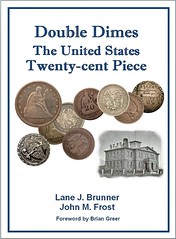 Double Dimes – the United States Twenty-cent Piece
Double Dimes – the United States Twenty-cent Piece
Lane J. Brunner and John M. Frost are pleased to announce the publication and availability of their new book, Double Dimes – the United States Twenty-cent Piece. The culmination of 30 years of research on the series, this book is the comprehensive reference on the short-lived twenty-cent piece.
With nearly 400 photographs, this highly-illustrated reference provides extensive coverage of varieties and every known die marriage, including die states, emission sequences, and rarity ratings. The book provides the collector with a wealth of new information never before published, and hopes to instill enthusiasm in new collectors. Other topics include the history of the series, patterns, a discussion on misplaced dates, collecting the series, grading, errors, exonumia, and survival estimates. A few interesting anecdotes round out the book with stories of discovery.
The book will debut at the ANA World’s Fair of Money in Rosemont (Chicago) Illinois the week of August 4, 2014. Author John Frost will be in attendance, and books will be available at the show. John can be reached at the Meeting of the Liberty Seated Collectors Club (LSCC) on Thursday morning, at the LSCC Club Table #1240 on Thursday and Friday, and on the bourse floor throughout the show.
Book information:
179 pages
8½x11-inch format
Spiral bound
ISBN: 978-0-9904593-0-9
Price: $50.00
Ordering by mail can also be done following the ANA at www.doubledimes.com.
There is also a web version of the book at doubledimes.com that can be accessed at no cost. This is especially useful at shows when one doesn’t have a copy of the book with them.
Questions and inquiries can be sent to the authors at info@doubledimes.com.
NEW BOOK: THE NUMISMATOURIST
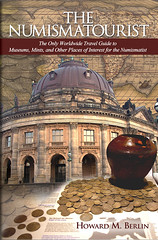 The Numismatourist
The Numismatourist
The Only Worldwide travel Guide to
Museums, Mints, and Other Places of Interest for the Numismatist
The Ultimate Coin Collector's Travel Guide
Here’s why:
- Covers coin collections on display in over 175 museums spanning 75 different countries.
- Includes important locations, times and must-see exhibits for the traveler and collector.
- Spans across North, Central, and South America, the Caribbean, Europe, Asia, the Middle East, Africa, and Oceania-Pacific.
- Rich with photography, maps, and historical context.
- No collector should travel without this book!
- Published by Zyrus Press. Written by Dr. Howard M. Berlin. 413 pages. 300+ photos. Full color. Paperbound.
Howard Berlin writes:
At long last, my book: The Numismatourist: The Only Worldwide Travel Guide to Museums, Mints, and Other Places of Interest for the Numismatist, has now been released. I will be signing copies of the book at the Chicago ANA at the Wizard Coin Supply booth at various times throughout the show.
The book spans 410 pages with index and covers more than 150 museums, mints, and central banks on five continents. Almost 100 of these institutions are described in depth with pictures.
The book is dedicated to the late Dr. Richard G. Doty, the well-known Senior numismatic curator, National Numismatic Collection of the Smithsonian Institution’s National Museum of American History. The foreword is written by Karen M. Lee, curator at the Smithsonian Institution. Comments on the book’s back cover are provided by Wayne Homren, editor of The E-Sylum of the Numismatic Bibliomania Society, and Dr. Ursula Kampmann, editor of CoinsWeekly (MünzenWoche) and the MintWorld Compendium.
This book was born from my “World Destinations” column that appeared in WorldWide Coins about my travels to places that feature various fascinating exhibits about coins and currency. The column had won the Numismatic Literary Guild’s “Best Column” award for world commercial numismatic magazines for two consecutive years. To my knowledge, this is first book of its kind and combines three of my favorite pastimes: numismatics, travel, and writing.
This is intended to be a worldwide travel guide for the numismatist, those whose hobby or profession is about coins and paper money. Inside you will find its contents to be a reference catalog of numismatic collections of exhibits in museums, banks, mints, and libraries around the world that are open to the general public. It is for the numismatist who is traveling, either on vacation or business, and wishes to visit places of interest.
Following my retirement as a college educator, I have had both the time and good fortune to travel. I have visited more than 50 countries, averaging about 75,000 miles annually—as the extra-page inserts and immigration stamps in my passport will verify. Some of these destinations, which had numismatic institutions of one kind or another, were first chronicled in my semi-monthly column. Prior to the column’s debut, Wayne Homren, the editor of the Numismatic Bibliomania Society’s electronic newsletter, The E-Sylum, dubbed me, the “Numismatourist.” I’m quite sure that there are many other travel writers that log more miles than I do, but I’m probably one of a very few with this peculiar niche—writing solely about visiting numismatic exhibits in museums, central banks, and mints.
Howard adds:
The book’s list price is USD 29.95 and may be ordered directly from the publisher’s Transline supply company toll free (US) at: 800-575-4008 or the website: http://www.translinesupply.com/zyrus-press-the-numismatourist-berlin-9781933990293
It is also available on Amazon.com, via the link: http://www.amazon.com/Numismatourist-Worldwide-Museums-Interest-Numismatist/dp/1933990295/ref=sr_1_1?s=books&ie=UTF8&qid=1405939438&sr=1-1&keywords=numismatourist

RUSSIAN WORKS OFFERED BY BALDWIN'S
Chaudoirs' Aperçu Sur Les Monnaies Russes
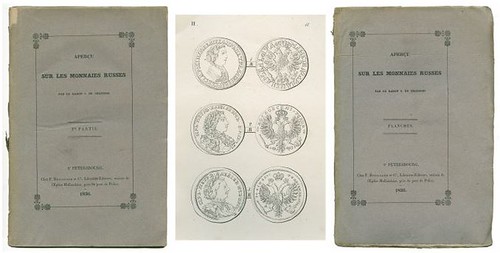
De Chaudoir, Baron S. Aperçu Sur Les Monnaies Russes et Sur Les Monnaies Etrangeres qui Ont Eu Cours en Russie. St Petersbourg, 1836. The first text and plates volume only – the second text volume sadly absent. Octavo, pp. 266, (2); 23, (1), 23 + 58 engraved tables and plates of coins, some folding. The first general guide to Russian coins. Infrequently encountered with the second volume of text which is unfortunate as it is this volume which provides the descriptions of the coins themselves.
Volume one gives a comprehensive history of the Russian monetary system as well as an extensive bibliography whilst the plates, quite apart from being copious in number, are all beautifully executed and are accompanied by tables of metal production and mintages etc. In the original printed wrappers, unopened and uncut. Extremities a little worn, spines sadly chipped but contents surprisingly bright and fresh. The classic reference, important and rare. Clain-Stefanelli 11138*
To read the complete description, or to order, see: Chaudoirs' Aperçu Sur Les Monnaies Russes (www.baldwin.co.uk/apercu-sur-les-monnaies-russes-et-sur-les-monnaies-etrangeres-qui-ont-eu-cours-en-russie.html)
Schubert's Famous 'Monnayes Russes'
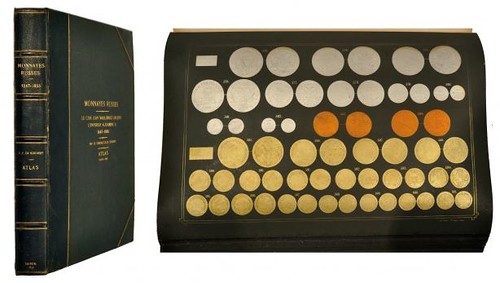
SCHUBERT'S RARE WORK ON RUSSIAN COINS WITH SUMPTUOUSLY PRODUCED EMBOSSED PLATES. Schubert, T. F. de. Monnayes Russes des Derniers Trois Siècles, Depuis le Czar Joan Wasiliewicz Groznyi Jusqu’à L’Wmpereur Alexandre II. 1547-1855. Leipzig, 1857. Plate atlas volume only. Oblong folio, title printed in gilt against blue background, engraved plate of edge designs and legends, 36 superbly executed embossed colour plates illustrating the obverse and reverse of over 1000 coins, all coloured with metallic tints. Bound in black half morocco boards, ruled and lettered in gilt, five raised bands, marbled endpapers. Some wear to extremities but overall a fine copy of this sumptuously produced work. A rare and desirable volume.
Ernst Shäfer (later Moritz Shäfer) was the most prolific publisher and producer of high quality embossed coin books. The coin images are universally bright, crisp and are astonishingly fine reproductions of actual coins. The plates in this copy are no exception and fortunately are also in an excellent state of preservation. Randolph Zander, in the Russian Numismatic Journal wrote that, “A striking if not altogether practical feature of the 1857 catalogue is the bound atlas… On the plates are 2144 embossed images showing the obverse and reverse of the 1072 major numbered types in the catalogue.
The embossed images in relief were produced on Congreve’s Press by means of clichés taken from galvano copies of the coins, many taken from collections other than Schubert’s in order to ensure the best example of each type. Bringing these together was a major undertaking in itself. The method of illustration, of which Schubert’s atlas was one of the early examples, had a certain vogue at the time… Given Schubert’s exacting methods of choice of specimens for illustration, the overall visual effect of each folio page of excellently embossed and metal coloured illustrations is impressive indeed… But if the coins suffer from cabinet friction, think of the havoc wrought by ‘page friction’ if the plates get much earnest consultation!’ Clain-Stefanelli 11191*
To read the complete description, or to order, see: Schubert's Famous 'Monnayes Russes' (www.baldwin.co.uk/monnayes-russes-des-derniers-trois-siecles.html)
BOOK REVIEW: A GUIDE BOOK OF U.S. PAPER MONEY, 4TH ED.
 A Guide Book of United States Paper Money, “The Official Red Book,” Fourth Edition, 2014, Authors: Arthur L. and Ira S. Friedberg, Published by Whitman Publishing, LLC, Reviewed by John & Nancy Wilson
A Guide Book of United States Paper Money, “The Official Red Book,” Fourth Edition, 2014, Authors: Arthur L. and Ira S. Friedberg, Published by Whitman Publishing, LLC, Reviewed by John & Nancy Wilson
This fourth edition of, “A Guide Book of United States Paper Money,” by Arthur and Ira Friedberg has incorporated many improvements since the last edition three years ago. The reference is soft-bound and has 416 pages with full color plates of the face and back of each note. Market values from very good to uncirculated 63 are given along with Friedberg numbers. Dennis Tucker, the publisher at Whitman Publishing, LLC said that, “We’ve seen a dramatic increase in interest in paper-money collecting since the first edition was published in 2005.”
Arthur and Ira Friedberg have over 30 years’ experience and their vast knowledge, experience and expertise is once again being put to great use with this book by Whitman.
The reference covers notes from $1 denomination to $10,000 along with error notes, signatures on U. S. currency, uncut sheets and other products of U. S. currency offered by the BEP. Quoting the media release for this book, “The fourth edition is even stronger than the critically acclaimed first, second, and third editions.”
As in the past three references of this book, you will find an introduction by past ANA President David L. Ganz, and chapters on the $2 bill, the Civil War years, The Bureau of Engraving and Printing (BEP), the buck starts here; the world at our fingertips, The Bank of the United States, how to collect United States paper money, grading U. S. currency; storage and care of paper money, types of U. S. currency which covers all the different types of paper money from 1861 to present including World War II issues, star notes, fractional currency, specimen notes and shields. Specimens are mentioned but not priced. Maybe in the future, a 5th edition can price them. The War of 1812 issues are covered, but they don’t cover a War of 1812 4 subject $3 sheet of which one is known which was in the Ford collection. Many of the collections of encased postage stamps have been sold in recent years so the prices listed are realistic and accurate. Maybe a future edition can include a chapter on the postage stamp envelopes.
Whitman has brought to the collecting community a reference that is easy to carry (the size of an actual Red Book), with U.S. paper money covered completely. Quoting the back cover of the book, “Market valuations are compiled from recent sale and auction records, real-world analysis of the paper-money field, and the knowledge of recognized hobby leaders.” For more information on this reference which retails for $24.95 (same as the last edition) you can contact the publisher at: Whitman Publishing, LLC, 3101 Clairmont Road, Suite G, Atlanta, GA 30329, Phone (404) 235-5300 or fax to (404) 235-5350 or visit the Whitman web page at: http:/www.whitmanbooks.com
MORE ON JOSEPH RUTLADER
Regarding Bruce W. Smith's query for more information on dealer Joseph Rutlader, Ron Benice writes:
Tokens issued by Joseph Rutlader purporting to be from Alaska have confounded collectors for decades. Here's the listing from the third edition of my Alaska and Yukon Tokens (McFarland, 2010) under Goodnews Bay where there had been an actual business called Alaska Traders. An illustration of the tokens from an earlier edition is also shown here.
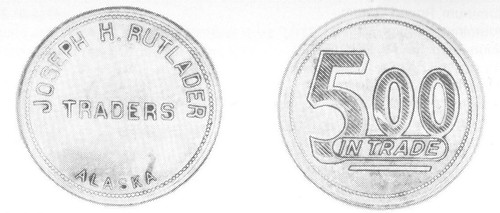
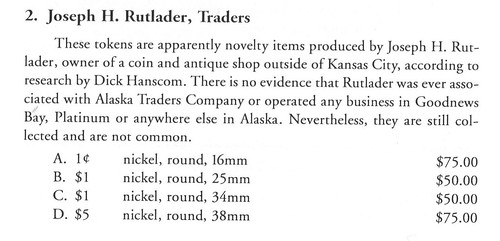
Dave Schenkman writes:
The bit on Rutlader rang a bell; I have a 1794 2 Reales with A. N. FORD counterstamp. Below that RUTLADER KANSAS is counterstamped in two lines. This part is of a completely differently style, and was obviously done much later.
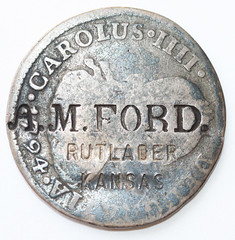
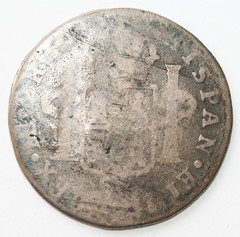
To read the earlier E-Sylum article, see: QUERY: JAMES RUTLADER INFORMATION SOUGHT (www.coinbooks.org/esylum_v17n30a13.html)
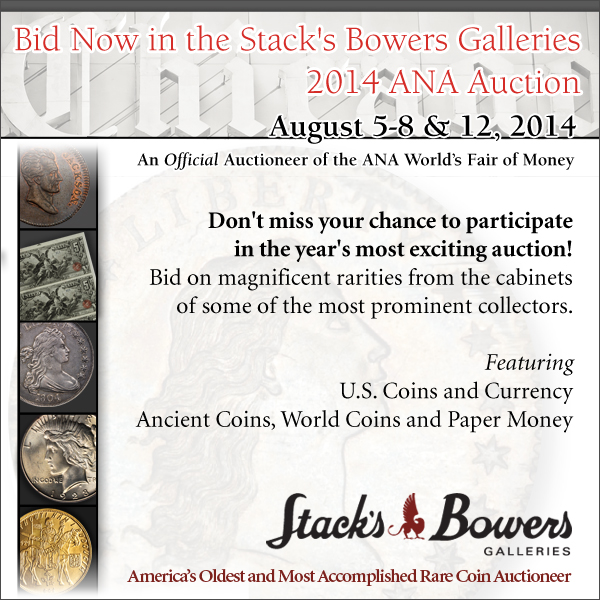
NOTES FROM E-SYLUM READERS: JULY 27, 2014
More on the Junior Numismatic Correspondence Club Web site visitor Kevin Angley writes:
I just happened to run across the article from June 15, 2014 on the Junior Numismatic Correspondence Club. ” I’ve done Google searches over the years for “JNCCA” just for fun, and this was the first time I’d seen mention of it.
As mentioned in the article, I was Secretary-Treasurer. I also was the one who published the newsletters in the early 70s (on my high school’s mimeograph machine). I remember some of the names mentioned in the article – Larry, Fred. I lost interest in coins after going to college, but to this day, have my collection.
If anyone else inquires about the article looking for former members, I can be found on Facebook or reached by email at kevin55@kevinangley.com .
To read the earlier E-Sylum articles, see:
QUERY: THE JUNIOR NUMISMATIC CORRESPONDENCE CLUB
(www.coinbooks.org/esylum_v17n25a17.html)
THE JUNIOR NUMISMATIC CORRESPONDENCE CLUB
(www.coinbooks.org/esylum_v17n26a16.html)
Containers vs Packaging Regarding his article last week Dick Johnson writes:
The headline is completely misleading. There is a difference between "container" and "packaging."
A container is what houses a coin or medal -- case, box, or envelope -- in which it is issued. Packaging is what you wrap it in for shipping -- bubble pack, Styrofoam peanuts, crushed paper or whatever, plus any outside shipping material.
I certainly did not imply to save the latter, only the former, as often a case, box or envelope reveals facts about the item inside. Rereading the article with this insight makes more sense than what your headline implies.
To me, "packaging" is more than just the container, and includes all the accompanying printed materials. The box and inserts are where some important numismatic information can be found, and we're in agreement on the value of saving these. -Editor
To read the earlier E-Sylum article, see: THE IMPORTANCE OF MEDAL PACKAGING MATERIALS (www.coinbooks.org/esylum_v17n30a09.html)
1150 Years of the French Mint Collin Bruno forwarded these five videos on the 1,150th anniversary of the French Mint. They are in French, of course, but do have a look - they're very well produced.
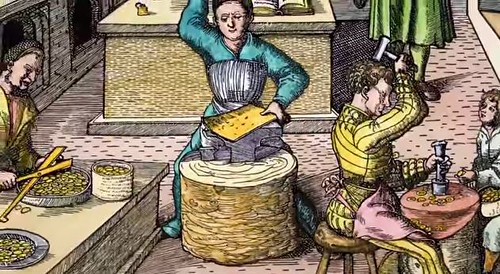
To view the videos, see:
La Monnaie de Paris, 1150 ans d'histoire - Chapitre 1
(www.youtube.com/watch?v=cIaFDdmfn5k)
La Monnaie de Paris, 1150 ans d'histoire - Chapitre 2
(www.youtube.com/watch?v=rENiL3IXCwI)
La Monnaie de Paris, 1150 ans d'histoire - Chapitre 3
(www.youtube.com/watch?v=OwbMyWi2unM)
La Monnaie de Paris, 1150 ans d'histoire - Chapitre 4
(www.youtube.com/watch?v=iiHva05eyHQ)
La Monnaie de Paris, 1150 ans d'histoire - Chapitre 5
(www.youtube.com/watch?v=DIA3VMfo9ks)
"Weird Al" Yankovic - Word Crimes
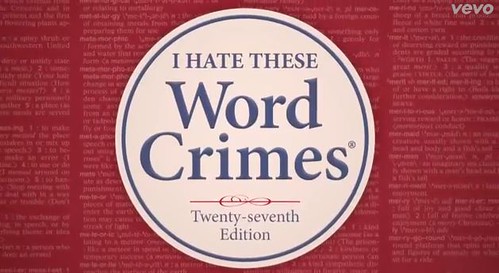
Fred Michaelson forwarded this AWESOME video from "Weird Al" Yankovic. Yes, he's still around. Who knew? While not numismatic, "Word Crimes" is delight for bibliophiles, "wordies" and grammar police alike. Watch it twice! Congrats to Jarrett Heather, who designed and animated the video, a parody of Pharrell’s infectious “Happy.”
To view the video, see: "Weird Al" Yankovic - Word Crimes (www.youtube.com/watch?v=8Gv0H-vPoDc)
For more on Weird Al's Internet Marketing Machine, see: The Surprisingly Savvy Weird Al Internet Machine (www.theatlantic.com/technology/archive/2014/07/the-surprisingly-savvy-weird-al-internet-machine/374649/)
THE BOOK BAZARRE
THE BROCK-NORWEB 1792 SILVER CENTER CENT
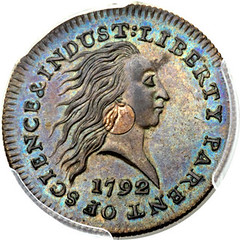

The Silver Center cent is one of the most significant and historically important coins ever struck at the Philadelphia Mint. It was the first coin actually produced inside the walls of the First United States Mint, as earlier patterns, like the 1792 half dismes, were actually struck in makeshift facilities before the Mint buildings were ready for operations.
Walter Breen, a numismatist who was not given to understatement, once remarked that the Silver Center cent was "deserving of more superlatives than we can bring ourselves to lavish on it." Just over a dozen specimens have survived, including one example in the National Numismatic Collection at the Smithsonian Institution.
The founding fathers apparently learned a great deal about establishing a monetary system from the earlier attempt by Robert Morris to set up a decimal coinage system with his program of Nova Constellatio patterns in 1783. Both Alexander Hamilton and Thomas Jefferson clearly saw the practical advantages of the decimal system, but wanted to avoid the complications arising from making the basic unit too small and unwieldy for use in everyday calculations. Based on the work of these two men, the Mint Act of April 2, 1792 authorized the establishment of a national mint...
Section 9 of the Mint Act specified that the cent should contain 11 pennyweights (264 grains) of pure copper. The planchet would be somewhat larger than the present-day half dollar, clearly too big for convenient use in everyday purchases (imagine carrying five half dollar-sized coins in your pocket to make a five-cent transaction). Henry Voigt, the ingenious chief coiner, suggested an innovative bimetallic solution to the problem. Voigt calculated that a coin with a tapered plug containing ¾ of a cent worth of silver inserted into a copper planchet worth ¼ of a cent would have both the proper intrinsic value and a convenient size.
The silver plug was to be conical in shape and inserted into a tapered hole in the copper planchet with the wider top of the plug on the obverse of the coin. When the resulting bimetallic planchet was struck on the screw press, the protruding edges of the plug would be fused with the surrounding copper and actually receive part of the design. A note in Henry Voigt's journal indicates that the first Silver Center cents were struck on December 17, 1792...
The present coin has an illustrious pedigree, tracing its history back to 19th century collector Robert C.H. Brock, who left this coin and a significant portion of his collection to the University of Pennsylvania. Financier J.P. Morgan acquired other parts of Brock's collection and later donated those coins to the American Numismatic Society, where they can still be seen today. The University of Pennsylvania deaccessioned its numismatic holdings circa 1952, with many coins going to dealer Philip H. Ward. After several intermediaries, this piece was a highlight of the famous Norweb Collection, one of the most important and valuable collections of all time. Several distinguished collectors have held the coin since then, including our present consignor, Oliver Jung.
To read the complete lot description, see: 1792 Silver Center Cent, Judd-1 (coins.ha.com/itm/patterns/1792-p1c-one-cent-judd-1-pollock-1-high-r6-ms64-brown-pcgs-secure-cac/a/1208-5517.s?type=collectora-3---coin--news--tem072614)
BOB EVANS ON THE SS CENTRAL AMERICA DOUBLE EAGLES
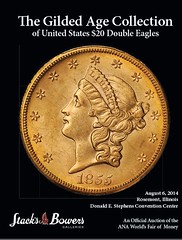 I like to think that I came into numismatics from the top down,
starting out with thousands of Mint State double eagles. Oh, it is true
that when I was a boy I briefly took an interest in plugging different
dates and mints of Lincoln cents into their proper holes in the blue
Whitman folder books.
I like to think that I came into numismatics from the top down,
starting out with thousands of Mint State double eagles. Oh, it is true
that when I was a boy I briefly took an interest in plugging different
dates and mints of Lincoln cents into their proper holes in the blue
Whitman folder books.
But it didn’t last. My collecting interests drifted toward picking up fossils and interesting rocks, most of them found scanning the limestone gravel of local driveways, parking lots and construction sites in the eastern suburbs of Columbus, Ohio where I was raised. I followed this interest into college, ultimately receiving my Bachelor of Science from the Ohio State University Department of Geology and Mineralogy. For my senior thesis I worked through a microscope, studying and measuring the details of animals that lived 400 million years ago. I was still a guy interested in fossils.
Who could have predicted that this background was a perfect preparation for what was thrust at me from the deep Atlantic. On September 12, 1857, the S.S. Central America had sunk far off the Carolina coast, carrying to the depths the greatest lost treasure in United States history.
In 1983, Tommy Thompson was my neighbor. He was a quirky, eccentric, innovative engineer who professed a dream of opening up the deep ocean frontier by focusing on its known resources, including valuable shipwrecks. The full story of our collaboration is beyond the scope of these paragraphs, but I joined his project, as of 1983 centered on the search for the fabled “Ship of Gold” and its storybook treasure. In 1988 our project hit pay dirt, finding the shipwreck site and with it not only a dazzling pile of gold, but also an incredibly rich numismatic time capsule.
Think of it—thousands of Mint State double eagles! Frozen on their pristine surfaces lay the physical record of the industrial arts of the United States Mint of the 1850s. I developed a technique to safely and responsibly remove the rust and mineral deposits obscuring these beauties. At first I was simply dazzled by how new they looked; in particular many of the 1857-S double eagles looked as if they had been made yesterday. But as I shared this material with other far more experienced eyes and minds, I began to appreciate just how special this treasure was.
James Lamb of Christie’s was the first real numismatist to see the treasure, visiting my shipboard laboratory, and declaring his experience to be the event of his or any other numismatist’s lifetime. I soon learned this was not mere hyperbole. James introduced me to John Ford and to Walter Breen, top experts brought in to lend their own thoughts to the increasing body of knowledge. Breen wrote an article for The Numismatist based on his examination of a few dozen pieces of gold at Christie’s New York office. The treasure was speaking volumes, and I was learning its language.
Breen introduced me to the existence of die varieties, and I was delighted to find that here was a place where my micropaleontologist’s skill set could apply. As I conserved more coins I became familiar with the more common varieties. Actually, I found the identification of varieties to be relatively easy. Whereas like any living things, the features of fossils could vary through infinite degrees of tiny differences, coins were clearly either one variety or another, with no ambiguity. The impressions left by those tools at the mid-19th century mints were immediately distinguishable. No question about it.
There were coins that showed tiny bumps on Liberty’s face, and I realized that these were the impressions left by a die that had rusted slightly, leaving me a little chilled by the idea that I could be looking at the result of a workman’s day-ending absentmindedness, forgetting to oil the dies for the overnight hours. I was seeing the footprint of a misty San Francisco night over 14 decades ago! Here was that fog, etched in gold for all time.
There were other groups of coins where the same variety showed successive die states, the devices receding into the fields, or the edges of the die cracking and the cracks propagating until ultimate replacement. I found year-transition dies, where the reverse of one year continued to be used with the next year’s obverse, at least for a time. Each new discovery was a personal delight.
As I became more familiar with numismatics, I saw that this sort of research had long before been introduced and refined with other series, obviously with Sheldon numbers for early copper, the VAMs for Morgan dollars, and similar cataloging of Liberty Seated and other series. The huge sample of double eagles in the S.S. Central America treasure, concentrated briefly in one conservation laboratory, made it possible for me to begin this process for the largest denomination of circulating United States coinage.
To read the complete catalog, see: The Gilded Age Collection of United States $20 Double Eagles (media.stacksbowers.com/VirtualCatalogs/2014/Stacks-Bowers-Galleries/aug2014-chicago-ana/SBG_Aug2014_ANA_GildedAge_Catalog_LR.pdf)
Rob Galiette writes:
People need to understand that there was almost no higher-grade double eagle material available for the production years prior to 1858, there not even being Proof $20 gold options prior to that date. I’m working on a brief research summary of the major gold auctions conducted during the 58 years when Liberty Head double eagles were produced between 1850 and 1907. During that time only one of these auctions, Woodward’s Heman Ely auction in 1884, had a circulation strike double eagle: a circulated 1850 $20 coin.
In the 85 years from 1850 through 1935, when Perry Fuller auctioned the Baltimore hoard of gold coins, the sixteen largest collections of U.S. gold at auction had a total of only eight Mint State Liberty Head double eagles among all of them. As a further note of interest concerning these eight Mint State coins, remarkably the first one of them in these sixteen landmark gold collection auctions did not appear until 1911, four years after double eagle production ceased in 1907..
The entire Liberty Head double eagle series is unlike any other in U.S. numismatics. It’s been necessary to treasure-hunt Liberty Head double eagles years after the original mintages of these coins -- from foreign banks, hiding places, the sea floor, etc.
Dave Bowers and I explain in this year’s double eagle book that paper currency introduced as “Greenbacks” by the Federal Government in 1861 traded at a discount to gold until they reached parity seventeen years later at the end of 1878. It might have required, for example, 160 paper U.S. dollars to purchase $100 in gold coin; or at another point, perhaps $220 or $135 in paper currency to purchase $100 in gold coin. The exchange rate regularly varied. There accordingly was a great preference for gold. The subject of this exchange disparity, as well as the California Gold Rush, continually were in the news.
Liberty Head double eagle gold coins in those years had almost no numismatic premium over face value. Even Proof gold Liberty Head double eagles sometimes sold at that time for only a dollar or two over face value. Therefore, you’d think that these large and impressive coins, by virtue of their low cost, beauty in Mint State, and historic significance, would have been included in landmark gold coin collections of those decades, and subsequent ones.
Yet it’s remarkable, for example, that 150 years after their production even the ten paired Civil War year P and S-mint $20’s from 1861 through 1865 never have been offered, until now, as a group in Mint State. Over 8.2 million U.S. double eagles were coined through those five years. Early double eagles are challenging to obtain even in circulated condition, because so many of the coins were melted and re-coined when they reached Europe at the time, well before the U.S. melting of its own gold coinage in 1933.
SELECTED PETER MAYER OBSOLETE BANK NOTES
District of Columbia. Bank of Washington $100 Proof

City of Washington, District of Columbia. Bank of Washington. ND (18xx). $100. Uncirculated. Proof. Likely Unique and Early Bank of Washington $100 Proof
(DC-385 G40). Murray, Draper, Fairman & Co. India paper mounted on paper sheet. Top, small oval portrait of Washington, olive branches encircle. Ornate ends. Left, ONE HUND. Right, ‘’Incorporated by Congress’’ in cartouche. The Haxby Plate Note. An exceedingly rare and possibly unique proof from this early, historic title founded in 1809. An old pedigree, updated since the 2005 Schingoethe sale. Formerly lot 202 of the Julian M. Leidman Collection sale conducted by McGlaughlin & Robinson in Lanham, April 20, 1985 (date on cover in error for those proof readers lucky enough to have this rare catalogue written by Doug Ball). It realized a strong $330.00 then.
To read the complete lot description, see:
City of Washington, District of Columbia. Bank of Washington. ND (18xx). $100.
(www.stacksbowers.com/BrowseAuctions/LotDetail/
tabid/227/AuctionID/6014/Lot/2016/Default.aspx)
Athol, Massachusetts. Millers River Bank. $5.
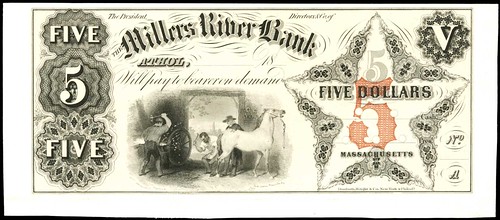
Athol, Massachusetts. Millers River Bank. ND (18xx). $5. Gem Uncirculated. Proof. Millers River Bank ‘’Star’’ Geometric Proof
(MA-35 G8 SENC). Danforth, Wright & Co. India paper mounted on archive book card. Red protector 5. Bottom left center, white horse being shod. Right, star-shaped filigree die with protector within. Very unique and used on only one other bank, New Castle Bank in Maine. Likely Unique.
To read the complete lot description, see:
Athol, Massachusetts. Millers River Bank. ND (18xx). $5.
(www.stacksbowers.com/BrowseAuctions/LotDetail/tabid
/227/AuctionID/6014/Lot/2053/Default.aspx)
St. Louis, Missouri Territory. Bank of Missouri $5
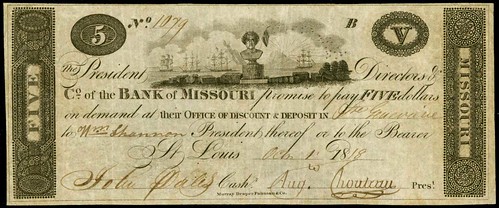
St. Louis, Missouri Territory. Bank of Missouri pay at their Office of Discount and Deposit in Genevieve. 1818. $5. Choice Very Fine. Iconic St. Louis Allegorical Imagery
(MO-30 G34 Design 5A). Murray, Draper, Fairman & Co. Top, bust of Jefferson on the banks of the Mississippi with ships and rising sun in background. Ornate end panels. Left FIVE and right MISSOURI. Hand signed by Auguste Chouteau as president of the bank. The top vignette, engraved for the bank’s sole use is an immensely moving allegory of Jefferson’s Louisiana Purchase transaction and of course St. Louis lay in that bounteous land acquisition. Beautiful example and well pedigreed. This came from the illustrious Dr. Vacca sale held by NASCA in its heyday in April 1981: 402.
To read the complete lot description, see:
St. Louis, Missouri Territory. Bank of Missouri
(www.stacksbowers.com/BrowseAuctions/LotDetail/tabid
/227/AuctionID/6014/Lot/2098/Default.aspx)
Auburn Exchange Bank $5
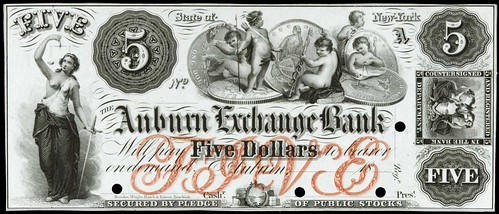
Auburn, New York. Auburn Exchange Bank. ND (18xx). $5. Choice About Uncirculated. Proof. Quintessential RWHE Silver Dollars Motif
(NY-190 G8a). Rawdon, Wright, Hatch & Edson, New-York. India paper only. Red protector cursive FIVE. Top, to the right, five Liberty Seated silver dollars with five cherubs. Left, standing semi-nude Justice. The Haxby Plate Note. Again, with exceptional style, the quintessential RWHE silver dollar vignette standing out. Likely unique. Originally part of a quartet of denominations from the British American Banknote Company archives sale held by Christie’s in 1997 (lot 172, once a sheet and then cut by the archive and placed into their archive book) and bought by Herb and Martha. Very petty top wrinkling only, virtually choice. A back cover note from the Schingoethe Part 16 sale catalogue. Ex Spink Smythe #291 Schingoethe Part 16, January 14, 2009: 360.
To read the complete lot description, see:
Auburn, New York. Auburn Exchange Bank. $5
(www.stacksbowers.com/BrowseAuctions/LotDetail/tabid
/227/AuctionID/6014/Lot/2102/Default.aspx)
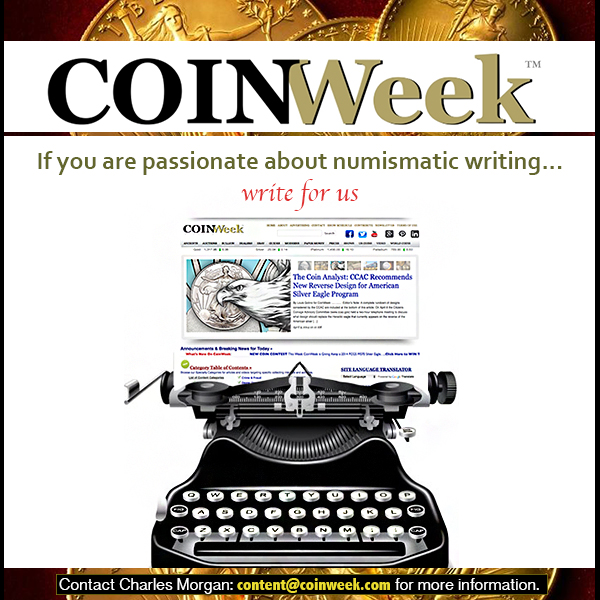
SELECTED STACK'S BOWERS RARITIES AUGUST 6, 2014
June 1722 Massachusetts Two Pence

June 1722 Province of the Massachusetts Two Pence. Parchment. Crosby page 149. Extremely Fine. Extremely Rare 1722 Massachusetts Parchment Two Pence Cited by Crosby within the Rosa Americana Series
Uniface, "Four-square" emergency bill of credit, face printed in black on vellum. 42 mm x 42 mm, virtually square. Mainly Gothic fonts within ornamental floral bordering. Top, divided circles, hand and 2d over "TWO PENCE." Above separator line, Gothic "Province of/the Massachu/setts." Followed by Roman "June 1722". Face printing style of Ford III: 512, though lighter printing. Characteristic vellum shrinkage similar to the observed Boyd piece cited. Newman plated example from the 4th edition differs in ornamental style and it is apparent that multiple plates or plate positions were used during the printing. Extremely Rare.
The exact census of known examples is not fully certain. We cite the Boyd piece now in a private collection, the Newman plate note from the 4th edition (the 5th edition plate note is now the Boyd note), an example in American Antiquarian Society, Worcester, Massachusetts and the Massachusetts Historical Society. As we note, most are well ensconced in collections with some likely never to be sold. This example is new to the collector fraternity and to our knowledge, the first time publicly auctioned.
To read the complete lot description, see:
June 1722 Province of the Massachusetts Two Pence
(www.stacksbowers.com/BrowseAuctions/LotDetail/tabid
/227/AuctionID/6014/Lot/13005/Default.aspx)
Stickney 1804 Dollar Presentation Case
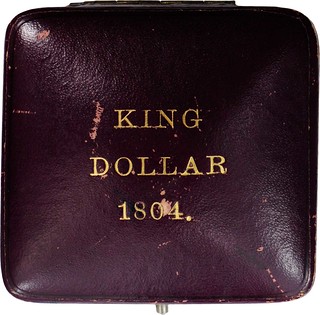
Custom Presentation Case that Once Housed the Stickney Specimen of the 1804 Class I Draped Bust Silver Dollar. 70 x 65 x 25 mm (greatest dimensions). Fine. Unique Presentation Box for the Stickney 1804 Silver Dollar Ex Elder-Mehl-Kosoff
An intriguing item, this purple leather case once housed the Stickney specimen of the famous Class I 1804 dollar. On the top of the case is printed in gold lettering KING / DOLLAR / 1804, while inside the lid is printed in smaller lettering THOMAS L. ELDER, / COINS & MEDALS, / 32 EAST 23 ST., / NEW YORK.
The dark blue plush interior upon which the coin once sat is in excellent condition, as is the white cloth interior to the lid. There are some chips and scrapes to the leather exterior, not so much on the top or sides of the case, but significantly so on the bottom, where residue from glue or some other kind of adhesive is also present. The clasp is still fully functional, however, and the case closes soundly with a nice snug fit. What a fine item for a museum or private collection!
Pedigree: Ex: Thomas L. Elder; B. Max Mehl; Abe Kosoff.
To read the complete lot description, see:
Custom Presentation Case that Once Housed the Stickney Specimen of the 1804 Class I
(www.stacksbowers.com/BrowseAuctions/LotDetail/tabid
/227/AuctionID/6014/Lot/13147/Default.aspx)
1881 Hawaii Five Cents

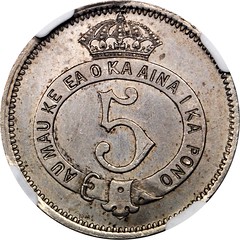
1881 Hawaii Five Cents. Medcalf-Russell 2CN-1. MS-63 (NGC).
Examples of this rarity are few and far between, and often a span of years will elapse between our offerings of them. The present coin is lightly toned in pale golden-tan on silver gray surfaces with full satin luster and a razor sharp strike. The obverse is smooth enough to support an even higher grade.
These rare pattern issue 1881 Hawaiian five-cent pieces were struck to the tune of approximately 200 pieces at the insistence of a nickel mine owner in New Caledonia who met with King David Kalakaua on the king's round the world trip in 1881 and 1882. The mine owner suggested the coinage, and dies were made in Paris where the pattern coins were struck. Today's collectors seek the "regular" issues such as the 1847 cent and the 1883 silver dime, quarter, half dollar, and dollar, and, as available, certain of the far rarer patterns.
To read the complete lot description, see:
1881 Hawaii Five Cents. Medcalf-Russell 2CN-1.
(www.stacksbowers.com/BrowseAuctions/LotDetail/tabid
/227/AuctionID/6014/Lot/13301/Default.aspx)
THE RIJKSMUSEUM NUMISMATIC COLLECTION
 The Rijks Museum readily admits that in the past, it hasn’t featured this important collection to its full potential but, this is about to change dramatically. We discussed the plans to include as many items, both coins and medals throughout the museum, as a comprehensive way of associating the relevance of these exquisite pieces and to tell a greater story of the history and development of the Netherlands into the country who, are also celebrating 200 years as an independent kingdom this year.
The Rijks Museum readily admits that in the past, it hasn’t featured this important collection to its full potential but, this is about to change dramatically. We discussed the plans to include as many items, both coins and medals throughout the museum, as a comprehensive way of associating the relevance of these exquisite pieces and to tell a greater story of the history and development of the Netherlands into the country who, are also celebrating 200 years as an independent kingdom this year.
If you are planning a visit to Amsterdam in the near future, I highly recommend adding the Rijks Museum to your itinerary and familiarize yourself with one of the world’s most outstanding collections of art and culture – you will not be disappointed by any means – and keep an eye out for those numismatic treasures placed alongside of the great masters & displays of artifacts – a most useful way of emphasizing the importance of our money and medallic history throughout the ages!
MA: Recently, the Rijksmuseum underwent a substantial and costly renovation which took more than ten years. What have been the greatest changes or additions which your department saw with the renovations?
GvdH: For the coins department specifically, much of the collection was hidden away for a very long time and only very small amounts of it were ever on view to the public. Most of the pieces were in storage so now, one of the goals I’ve set is to make many of those pieces “more public” as it once was. One particular way to do this is to increase their display by making them part of the chronological circuit that makes use of the presentation of the art & history – all collections are “mixed” together to tell different stories rather than just keeping everything separate. In this way you can encounter coins and medals everywhere, so they form part of the bigger story of the development of Dutch society, culture and nation.
We have made room to display a small part of the collection in the same place where, when the museum first opened, the entire coin & medal collection was displayed. They were mounted on boards and in cabinets and placed around the beautiful balcony of the library which has retained the original style of the museum’s architecture. One particular part of the collection we obtained in 1885 was that of a private Dutch collector Pieter van Gelder who was very interested in the history of the Netherlands through medals rather than coins.

MA: At present, and not counting the many other artifacts here at the Rijksmuseum, can you tell me how many coins and medals are currently included in the collection and how far back some of the collection is dated?
GvdH: The basis of our collection is primarily made up from two prominent collectors whose collections were obtained by the Museum around 1885. Specifically included are those of the van Gelder family, both father and son who collected Dutch historical medals of different kinds and times, and of Mr. Maschhaupt, who mainly collected medals from Dutch guilds and from Dutch city governments. The first one is considered a typical nationalistic 19th century collection. The two collections together consist of 10,000 medals which nearly all of them are Dutch.
We also have about two thousand coins – a significant part of the coin collection, 500 pieces consist of emergency coins. Made during the first years of the Dutch revolt against Spanish rule in the 1570´s, and in 1672 when Holland was attacked by France, England and two German states (Munster and Cologne). In the besieged towns, emergency coins were made, from church silver for example, and for the history of the Netherlands, it’s a very important numismatic chapter.
To read the complete article, see: Amsterdam’s Rijksmuseum Numismatic Collection (news.coinupdate.com/amersterdams-rijksmuseum-numismatic-collection-3390/)
THE BOOK BAZARRE
EXHIBIT ON POLITICAL MESSAGES ON COINS AND BANK NOTES
Disobedient Objects, edited by Catherine Flood and Gavin Grindon (V&A, 2014), is being published Saturday in connection with the opening of London's Victoria and Albert Museum show about how design is used to effect social change. Here at the Eye, the authors share a brief adapted excerpt about the history of defacing currency as an act of political defiance.
There is a long history of defacing coins and bank notes in order to slip a political message into circulation. Sometimes this is done as a direct and immediate gesture of graffiti, such as when in a miniature act of defiance Libyans scribbled out the face of Muammar Qaddafi on bank notes after he fell from power in 2011. In other cases there is a more involved design process. A currency is a highly controlled symbol of a state, and tampering with it is a small but powerful act of subversion.
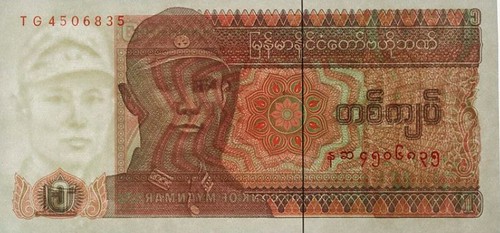
When Aung San Suu Kyi won an overwhelming election victory in Burma in 1990, the military junta ignored the result and placed her under house arrest. Displaying her image, even in private, became grounds for imprisonment. At this time a designer working on a new bank note featuring Gen. Aung San—the father of Aung San Suu Kyi—decided to subvert the commission. In the portrait drawn for the watermark, the features of the general have been subtly softened to resemble the face of his daughter. For a few months before the government realized and withdrew the “democracy note,” people in Burma could hold up their bank notes to the light and see a hidden portrait of the opposition leader.
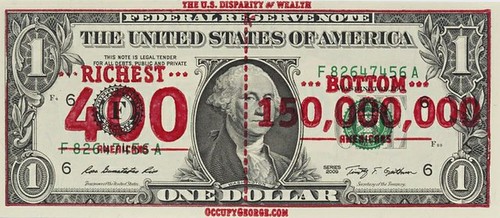
Inspired by the Occupy movement that began in New York City in 2011, artists Ivan Cash and Andy Dao began Occupy George and created a set of fact-based stamps illustrating wealth disparity in America (top image). They could be found stamping the messages onto dollar bills throughout protests in San Francisco, Oakland, and Berkeley. The designs were released on the Internet enabling anyone to participate. The very money that has divided America was utilized to communicate the heart of the problem. In this example it is revealed that the richest 400 people in America have as much wealth as the poorest 150 million.
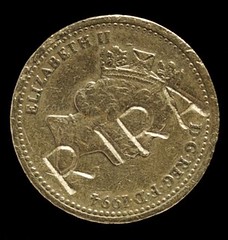
Stamping coins with paramilitary slogans was prevalent in Northern Ireland from the 1970s and throughout the period of the Troubles, especially in border counties where both British and Irish currencies were used alongside each other. The coins were generally stamped by metal workers and mechanics in their tea breaks as a popular everyday practice of political expression rather than an organized campaign. Two of the Irish coins bear the acronyms of the Loyalist paramilitary group the Ulster Volunteer Force and the Ulster Defence Association. A later Republican example from the 1990s has RIRA, short for Real Irish Republican Army, stamped over the head of the queen on a British pound coin.
To read the complete article, see:
Spreading Political Messages Using Coins and Bank Notes
(www.slate.com/blogs/the_eye/2014/07/25/
disobedient_objects_at_the_victoria_and_albert_museum
_looks_at_currency.html)
To order the exhibit catalog, see: Disobedient Objects (Paperback) (www.vandashop.com/Disobedient-Objects-Paperback/dp/B00L3746NG)
DAVE WNUCK'S COIN IMAGE LOGO
When I first started up my own coin firm once again, lo those many weeks ago, one of my goals was to keep overhead to an absolute bare minimum. I wanted to do everything myself. My focus was (and still is) on the coins and the coins alone.
That’s all well and good, but like most people, I am better at some tasks than others. One of the things I am not good at is anything at all artistic.. I have no talent for it; I greatly admire those who do have it.
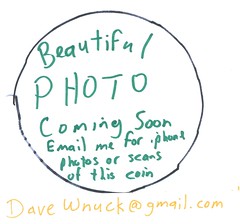 Nevertheless – in the first few days after my website was up and running I realized I needed some sort of graphic to insert in place of a photo of a newly purchased coin that I did not yet have. Sounds simple enough. “I’ll do it myself!”
Well, here is the result:
Nevertheless – in the first few days after my website was up and running I realized I needed some sort of graphic to insert in place of a photo of a newly purchased coin that I did not yet have. Sounds simple enough. “I’ll do it myself!”
Well, here is the result:
I want you to know that I did not purposely try to make it crappy. It just came out this way.
So – did I realize that it was so bad that it looked like a chimp drew it? No. I told myself that it was quaint. Charming even. Perhaps akin to folk art.
And I began to use it. Really. And since I had very few photos of my new purchases in the beginning, that graphic showed up on my site a lot.
Luckily a guardian angel was looking out for me. A guardian angel in the form of Matt Powell, a coin dealer/website builder/graphic artist extraordinaire. Here is a link to Matt’s website: http://www.digitalstudionw.com
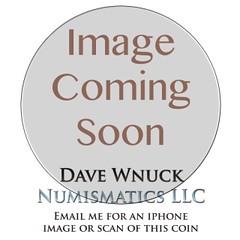 He sent me an email saying that he took the liberty of designing some graphics for me that I might want to use on my website instead of what I was using. I was surprised & delighted, and I gladly accepted his charity. Here is the one I chose:
He sent me an email saying that he took the liberty of designing some graphics for me that I might want to use on my website instead of what I was using. I was surprised & delighted, and I gladly accepted his charity. Here is the one I chose:
Also luckily, not many of you saw the old graphic, as I was probably averaging about 3 views per day on my website at the time. [Not to brag or anything, but these days I’m getting almost triple that].
My takeaway from all this: Do such a lousy job that you get unsolicited charity from someone more talented.
Or maybe -- just maybe -- there are genuinely nice people out there who enjoy helping others. Thus with the help of others my website continues to evolve.
Below are a couple of the coins that caught my eye in Dave's newsletter. He's got a great taste for interesting and important numismatic items. -Editor
Lincoln Cent Struck on a Silver Netherlands 25c Planchet

1944 Lincoln Cent. Error: Struck on a Silver Netherlands 25c Planchet. PCGS graded MS63.
This is a coin that will stop you in your tracks. It has the look of a choice uncirculated 1943 steel cent. But wait! It is dated 1944! As comedian Steve Martin would say, “What the dang deal is goin' on here?” This certainly qualifies as a coin which I term a “One coin collection”.
Bechtler $5 Gold Contemporary Counterfeit
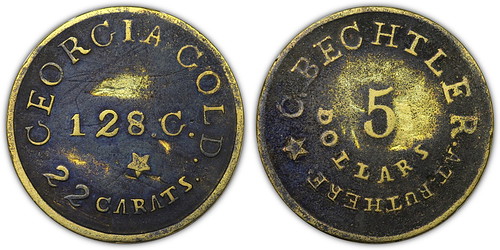
1843-D $5 Gold Contemporary Counterfeit. Struck in Copper. Fine [uncertified].
Hand cut dies, some wear, with none of the original gold wash remaining. This coin could tell some tales, I am sure.
To visit Dave's web site, see: www.davewcoins.com
MAN STRIKES IT RICH WITH 1969 S DOUBLE DIE CENT
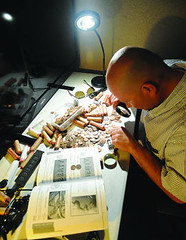 A Yuma man turned a few dollars into thousands in June after he sold a double-stamped penny for $21,510 at an auction on June 5.
A Yuma man turned a few dollars into thousands in June after he sold a double-stamped penny for $21,510 at an auction on June 5.
Last December, William Gaitan visited the Foothills Walmart with his girlfriend to pick up their prescriptions. While there, Gaitan went to exchange $3 for pennies with hopes of finding a coin worth a substantial amount of money. His efforts paid out in spades.
Gaitan was given a book, “Strike It Rich with Pocket Change,” by his girlfriend’s son, who is an avid coin collector, in 2011. Since then, he has developed an obsession of sorts with coins and was on the hunt to turn a profit from the bronze and silver specie.
“They only had five rolls of pennies and a couple of quarters,” said Gaitan of the Sun Bank inside Walmart. It was in one of those rolls that he found a 1969 S Double Die penny. Double Die means that the penny has undergone a mint error where every number and word is stamped twice on the coin. “When I found it, I knew exactly what it was instantly, I just had to verify it,” said Gaitan.
“All the letters in it were double stamped. Everything was double stamped,” said Gaitan.
His family did not believe him at first. “They thought I was crazy,” said Gaitan. But after he showed them the exact same penny in the book and how much it was worth, they started to believe him. “I was using that book as a guide.”
His Internet exploration led him to the Professional Coin Grading Service (PCGS), which certifies coins. “Me and my daughter drove (the penny) to Long Beach and I dropped it off at the PCGS coin show,” said Gaitan. “Next thing I know they emailed me saying it was authentic and it was valued at $24,000.”
To read the complete article, see: Collector's rare coin sells for $21K (www.yumasun.com/news/collector-s-rare-coin-sells-for-k/article_160a4dce-105a-11e4-bdd0-001a4bcf6878.html)
"CONFEDERATE" 1861-O HALF FOUND IN KENNEDY ROLL
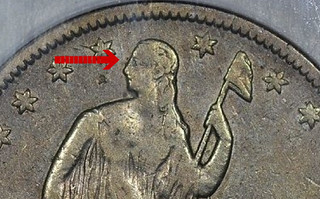 You never know what you’ll get when you sort a roll of coins. One lucky man in New Orleans got the find of a lifetime. He found a very special 1861-O Seated Liberty half-dollar hiding in a roll of Kennedy half-dollars.
You never know what you’ll get when you sort a roll of coins. One lucky man in New Orleans got the find of a lifetime. He found a very special 1861-O Seated Liberty half-dollar hiding in a roll of Kennedy half-dollars.
After undergoing knee surgery, this unnamed coin collector decided to sort through rolls of Kennedy half-dollars to pass the time while recovering. He was looking for silver half-dollars, because if they were minted before 1964, they would be worth more than fifty cents. Some of them, a lot more. In the past, he’d had a lot of luck finding coins that he could turn around and sell for a profit. But never like this. The 1861-O Seated Liberty half-dollar he found is valuable not only for its age, rarity, and silver content, but for its history as well.
The coin he found was minted in New Orleans during the Civil War. Unlike other Seated Liberty half-dollars from the New Orleans mint, this coin was produced while the mint was under Confederate control. Coin experts determined this by a unique die break on the obverse side of the coin.
Incredibly, that wasn’t the only find he made. In one of his last rolls of JFK half-dollars, the collector discovered an 1869-O Barber half-dollar! Unfortunately, this piece was far more damaged and not as rare, making it less valuable. Still, it’s a pretty good score for the price of a roll of half-dollars.
To read the complete article, see: Rare Silver Coin Found in Roll of Half Dollars (www.wscbrc.com/archives/rare-silver-coin-roll-dollars)
THE BOOK BAZARRE
CREATING THE KENNEDY HALF DOLLAR
On Dec. 10, 1963, President Lyndon Johnson asked Congress to authorize the new Kennedy coin. The Associated Press reported, “If approved quickly, present plans are to have the coin in circulation early next year.
“The design — to be taken from a ‘presidential series medal’ now being produced in Philadelphia — is already in existence and little cost or delay would be entailed in making new dies, the White House said.”
The cost was estimated at $1,000. The bill quickly and nearly unanimously passed both houses of Congress. “Few House members, however, were willing to risk a vote at this time against anything carrying the Kennedy name.” Elston G. Bradfield reported in The Numismatist. Johnson signed the bill Dec. 30.
Mint officials, however, did not wait for formal approval of the legislation to make the necessary hub and die tooling, and start producing test strikes of the 1964 coins even before the bill became law. In his report to Adams on April 29, Gasparro wrote, “At 9 a.m. on Dec. 13th we struck our first trial (pattern) pieces.” That same day he flew to Washington to deliver the coins to Adams who, in turn, sent them to Treasury Secretary Douglas Dillon and President Johnson.
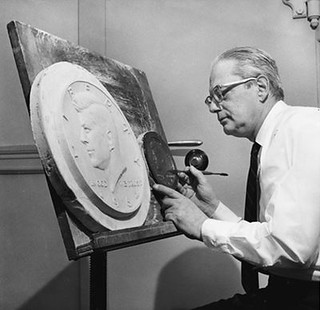 On Dec. 17, Roberts showed a prototype of the coin to the president’s widow. He told interviewer David Lisot in a videotaped American Numismatic Association Numismatic Profile in 1991, “They wanted Mrs. Kennedy to see — this is the portrait that is on the half dollar. And I had emphasized the part in his hair.
On Dec. 17, Roberts showed a prototype of the coin to the president’s widow. He told interviewer David Lisot in a videotaped American Numismatic Association Numismatic Profile in 1991, “They wanted Mrs. Kennedy to see — this is the portrait that is on the half dollar. And I had emphasized the part in his hair.
“He had a great shock of hair as you recall, and most artists, when they did a Kennedy portrait, they made a lot of this shock of hair, thinking that’s going to help them to make it look like Kennedy, you know. Well, they were right, but they had a tendency to overemphasize this part in his hair. And Mrs. Kennedy looked at the coin, and she said, ‘Could you muss up his hair a little bit?’
“All right, I thought, that was a wonderful criticism. She was a bit of an artist herself, and I think that aspect of the likeness was the first thought in her mind. It was very helpful, so I mussed up his hair and sort of half hid the part, made it less obvious, which helped. It was good criticism so I thanked her, too, for that helpful hint.”
The obverse design was revised to “muss” the hair and another trial strike made. Roberts flew to West Palm Beach, Fla., Dec. 27 to show the revised design to the Treasury secretary, who signed off on it.
To read the complete article, see: 50 years later: Jackie O asks for 'mussed up' hair on Kennedy half dollar before Congress' near-unanimous approval (www.coinworld.com/insights/kennedy-half-dollar-50th-anniversary-coin-world-numismatics-jfk-jackie-o-collecting.html)
THE KENNEDY HALF DESIGNER INITIALS CONFUSION
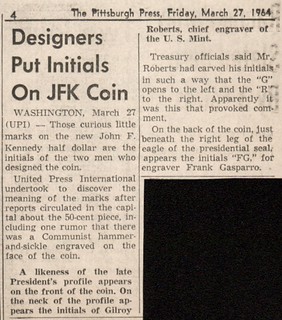 I bought several inexpensive books at the Summer FUN show from a dealer in vintage numismatic literature who doesn't seem to set up at the other shows I attend around the country. The items I purchased were mostly things that everyone else passes over, such as dealer-published coin guides, checkout stand booklets, etc. I buy these to flesh out my collection of coin folders and albums.
I bought several inexpensive books at the Summer FUN show from a dealer in vintage numismatic literature who doesn't seem to set up at the other shows I attend around the country. The items I purchased were mostly things that everyone else passes over, such as dealer-published coin guides, checkout stand booklets, etc. I buy these to flesh out my collection of coin folders and albums.
In one of these cheap books I found the attached clipping from the Pittsburgh Press dated March 27, 1964. That was just three days after the release of the Kennedy Half Dollar, and the coin was receiving a lot of public attention. I'd always read in coin books and magazines about how Gilroy Roberts' initials were said by some to be the hammer-and-sickle emblem of the Soviet Union, but until now I hadn't encountered a contemporary reference to it.
GOLD KENNEDY COINS RETURN TO ORIGINAL DESIGN
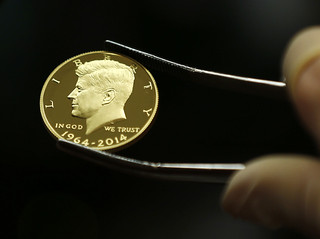 John F. Kennedy is getting his old look back on new collectors' coins.
John F. Kennedy is getting his old look back on new collectors' coins.
The slain president's profile debuted on the half dollar 50 years ago, and the image was subtly tweaked and sharpened in the 1990s. Now the U.S. Mint is producing collectors' coins that restore the original 1964 design, which incorporated suggestions from a grieving Jacqueline Kennedy.
Gold coins being stamped at the mint's West Point plant this week portray JFK's famously tousled head of hair a bit fluffier, his part is less severe and his cheeks less chiseled than on the half dollar discontinued in 2001. The throwback design being featured on the coins this year is truer to both the president's appearance and his widow's wishes, mint officials say.
"We felt we got away from the original," said West Point plant manager Ellen McCullom. "This really does look a lot more like him ... one of the things that struck me was even the little differences in the nose, and in the face and the lines around the eyes."
In the 1990s, improved technology allowed for tweaks in the design to show more detail — sort of the engraver's version of a high-definition broadcast. Not only did JFK's part become pronounced, but the strands of his hair became more defined, a characteristic collectors sometimes refer to as "spaghetti hair." His cheeks became more angular, too.
The mint stopped making the Kennedy half dollar for general circulation in 2001, but it has continued on as a collectible coin.
The evolution of JFK's profile in coinage was noticed last year by San Francisco mint employee Michael Levin, who convinced higher-ups that the original design was fuller and more lifelike. That led to the old profile making a comeback on three products from the mint this year. The coin's "tail" side, a presidential coat of arms, is unchanged.
The gold proof coins being made at West Point with three-quarter ounces of 24-karat gold will begin going on sale Aug. 5 at the World's Fair of Money in Rosemont, Illinois. That coin will be dated 1964-2014 and its price will be around $1,300, depending on the market price of gold.
To read the complete article, see: Profiles in Coinage: JFK returns to more lifelike look in collectors' coins made at West Point (www.greenfieldreporter.com/view/story/14863beecc6f4497b5be7ce201735c84/US--JFK-Coin)
DOUBLE SOLIDUS OF AELIA EUDOCIA
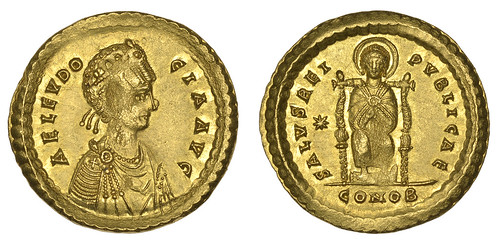
An extremely rare gold Double Solidus or Medallion depicting Aelia Eudocia, wife of an emperor of the eastern Roman Empire and later an enlightened ruler of Palestine in her own right, is expected to fetch £80,000 to £100,000 ($137,000 to $171,000) at Dix Noonan Webb, the international coins and medals specialists, in London. It is believed to be one of only three surviving examples and will be auctioned in the sale of Ancient and World Coins on 22-23 September 2014.
The coin was struck in Constantinople in the 5th Century and was probably a special commemorative piece given to courtiers for services to the imperial family. Eudocia is depicted wearing her imperial regalia on the obverse, while on the reverse she is shown enthroned and wearing a halo, a symbol of sovereignty, enlightenment and divinity.
Eudocia was an extraordinary woman who deserves to be more widely remembered. Born in Athens, she travelled to the court of Theodosius II, emperor of the eastern part of the Roman Empire, in Constantinople in 420 to challenge her father’s will. Theodosius fell in love with her and she married him in 421. The dynastic title Aelia was added to her name.
Theodosius gave Eudocia imperial powers previously held by his sister Pulcheria and struck coins depicting her. These are part of the transitional coinage bridging the changeover from the late Roman to the Byzantine eras. Pulcheria was angry that her powers had been handed to Eudocia and this provoked a bitter dispute between them. In 441, several years after the Double Solidus to be auctioned was struck, Eudocia was accused of adultery, probably falsely, and banished.
Eudocia went to Jerusalem and, as the most senior member of the imperial family living in Palestine, became ruler of the province. She proved to be very enlightened, protecting all religions from the discriminatory laws imposed by her husband and overseeing the construction of major public buildings. After her death in 460, Roman historians ignored Eudocia because she was said to have fallen into disgrace but the people of Palestine honoured her memory.
Dix Noonan Webb
16 Bolton Street,
London W1J 8BQ
Telephone: 020 7016 1700.
E-mail: auctions@dnw.co.uk
KÜNKER AUCTION SALES 249-252 RESULTS
30 June – 4 July, 2014
Fritz Rudolf Künker, Osnabrück
Auction sales 249-252
Top prices realized in jubilee auction week at Künker’s
Hammer prices amounting to more than 9.3 million, markedly more than 50 % above the estimate of 6.15 million, individual prices ranging between 20 euros and 170,000 euros: Künker proved that virtually every collector can find its piece in the Künker auction sales.
It was a gorgeous celebration that took place on the occasion of Künker auction #250 in Osnabrück on 2 July, 2014. More than 300 guests gathered to join in and embrace the opportunity to examine the new business premises in Nobbenburger Straße 4a first-hand. Naturally, all these guests were keen bidders as well during the auction week over the course of which 5,000 lots changed hands in four auction sales. The total hammer price of 9.3 million euros, hence more than 50 % above the estimate of 6.15 million euros, testified to the market being quite healthy.
Jubilee auction sale 250 – Coins of the Kingdom of Prussia: The Masuren Collection
A magnificent event was the 250th Künker auction sale during which the Masuren Collection was sold. In the morning, Oliver Köpp compared it with the most important collection of Prussia that was ever auctioned, i.e. the one of Otto Killisch von Horn in Berlin that came on the market in 1904. The baron, however, would have been amazed to see what prices the rarities in finest grades are able to realize!
65,000 euros was the sum for which the splendid first strike of the speciesthaler 1755 of Frederick II, which was never actually issued, changed hands. There are only 16 specimens of this speciesthaler, only three of which had been available on the market since WW II.
The levantethaler of the very king 1767 cost 30,000 euros. And a pattern of the reichsthaler 1714 for Neuenburg under the Soldier King Frederick William I realized 40,000 euros. The surprise of the day was a reichthaler from Cleve from 1752 that stood out due to its fantastic condition. Having been estimated rather modestly, at 4,000 euros, the exceptional coin rose to the incredible sum of 34,000 euros!
We could go on talking about results in the five-figure regions. Like, for example, the Williams dor from 1740 in very fine to extremely fine that started with an estimate of 3,500 euros only to arrive at 24,000 euros in the end! Or the very rare reichsthaler of Frederick William I that obtained not the expected 8,000 euros but 22,000 euros instead. Yet all these six-figure results would only hide the fact that collectors with less money to spend had a decent chance to acquire an interesting piece as well. Just like any true collection, the Masuren Collection comprised not only an A-list but a B-list as well. Bids as low as 20 euros were accepted, and one bidder actually was lucky at that sum. Most of the lots were sold for prices ranging in the lower three-figure regions.
Auction sale 249 – Coins and Medals from Medieval to Modern Times / Münster and Westphalia, The Dieter Braun Collection It goes without saying that the Masuren Collection was not the only highlight of this auction week. It had already started with a bombshell, albeit a bombshell that was to be expected. Künker had offered in previous auctions patterns of Chinese coins that had been produced by the Prägeanstalt Otto Beh in Esslingen in 1897. Every time so far the result has exceeded the estimate by far. This auction sale included four examples – all coming with a pre-sale price tag of 5,000 euros. There were huge differences regarding the results achieved. While the 10 cash piece from the Huan Province increased to ‘mere’ 11,000 euros and a 20 cent piece from the Fentien Province to 20,000 euros, the patterns for the Heilongjiang Province, adjacent to Russia, obtained 24,000 and 75,000 euros, respectively!
That a coin collection that was assembled with love, interest and expertise not only brings a great deal of joy but might become an interesting investment as well was proven by Dieter Braun who, over the course of decades, had put together a collection that was special in the literal sense of the word: Münster and Westphalia in the Context of the European Monetary History.
Absolutely every collector of this field had shown up, and so the great rarities realized the appropriate prices, and this goes not just for the eye-catching gems. This is just one telling example: you had to really know the subject to recognize the pfennig of Burchard von Holte (1098-1118), bearing lot no. 1674, as being something special. The potential customers were well aware and made the piece increase from 250 euros to 2,800 euros. Much more obvious was the case of the goldgulden of Heinrich von Schwarzburg (1466-1496) that sold for 17,000 euros (estimate: 10,000 euros). The three most expensive coins had all been struck by order of Bernhard von Galen: a 6 ducat piece 1661 realized 28,000 euros, a double ducat n. d. 34,000 euros and a 1.5 ducat klippe from 1652 likewise 34,000 euros.
Auction sale 251 – Gold Coins / Russian Coins and Medals These, however, were by no means the highest prices the auction week witnessed. It was left for the gold coinage in auction 251 to win that title. The most expensive coin of the auction week became a Polish 5 ducat piece 1623 from Bromberg of which only three examples are known to exist. The bidding fight for the perfectly preserved item only stopped at 170,000 euros! That makes about 210,000 euros for the proud new owner to pay.
The other results likewise were nothing to sneeze at, though. The 5 pound piece 1839 of the “Una and the Lion” type had been estimated at 50,000 euros although the end result was not less than 65,000 euros. A rare 10 ducat piece from Czechoslovakia from Kremnitz from 1951 with a mintage of just 56 specimens brought 50,000 euros, and a Hungarian 10 ducate piece of Michael Apafi, minted in Klausenburg in 1671, 38,000 euros.
Germany saw some marvelous results, too. A 10 thaler piece of Charles I of Brunswick-Wolfenbüttel, minted in Brunswick in 1779, cost 20,000 euros (estimate: 10,000 euros), an extremely fine 5 thaler of the duke of Mecklenburg-Schwerin from 1754 realized 16,000 euros (estimate: 5,000 euros), and an extraordinarily preserved 6 ducat piece 1698 from Nuremberg on the anniversary celebration of the Treaty of Ryswick 44,000 euros (estimate: 7,500 euros).
Naturally, the Russian coins sprang many a surprise as well. A rouble of Ivan III from St. Petersburg from 1741 rose to 52,500 euros (estimate: 30,000 euros), a rouble of Nicholas I 1841 on the wedding of his son realized 40,000 euros (estimate: 15,000 euros), while a gold medal of Alexander II from 1859 on the erection of the monument for Nicholas I even brought 100,000 euros (estimate: 75,000 euros).
A real surprise was the modest, but extremely rare silver badge from Fabergé as numismatic documentation of the beginning of the construction of Russian submarines in 1914. Having been estimated at just 1,000 euros, the impressive hammer price was 22,000 euros in the end.
Auction sale 252 – German Coins since 1871 Let us conclude this review with some remarkable results from the section of Imperial Coinage. The Saxon 3 mark piece “Frederick the Wise” in proof changed hands for 67,000 euros. The 20 mark piece 1873 from Mecklenburg-Strelitz in extremely fine to proof-like increased from 10,000 euros to 21,000 euros, and the same denomination from Saxe-Coburg-Gotha from 1872 in good very fine to 52,500 euros, while the hammer fell at 30,000 euros (estimate: 20,000 euros) for a 20 mark piece 1895 for German New Guinea in about proof-like.
By the way, the unique pattern of the Saxon “Frederick the Wise” likewise rose a bit higher compared to its pre-sale estimate. It increased from 5,000 to 15,000 euros. If the new owner wanted this pattern as substitute or rather as supplement for the same piece in silver, we cannot say for sure.
You may find all results on the Künker website at www.kuenker.de. Our autumn auction sales are scheduled for 6 to 10 October, 2014. The catalogs can be requested at Künker, Gutenbergstraße 23, D-49 076 Osnabrück; phone: +49 (0)541 / 96 20 20; fax: +49 (0)541 / 96 20 222; or by email: service@kuenker.de.
Lot 460: CHINA. Prägeanstalt Otto Beh, Esslingen. Heilongjiang Province. Pattern of 20 cents (1 mace, 4.4 candareens) n. d. (1897) in brass. Unpublished. About proof-like. Estimate: 5,000,- euros. Hammer price: 75,000,- euros
Lot 1674: MÜNSTER. Burchard von Holte (1098-1118). Pfennig, Münster. Ilisch IV, 3var. Very rare. Good very fine. Estimate: 250,- euros. Hammer price: 2,800,- euros
Lot 1714: MÜNSTER. Konrad von Rietberg (1497-1508). 1/2 goldgulden n. d., Münster. Fb. 1757. Extremely rare. Very fine. Estimate: 7,500,- euros. Hammer price: 17,000,- euros
Lot 1729: MÜNSTER. Christoph Bernhard von Galen (1650-1678). 2 ducats n. d. (1661-1678), Münster. Fb. 1768. Extremely rare. Extremely fine. Estimate: 10,000,- euros. Hammer price: 34,000,- euros
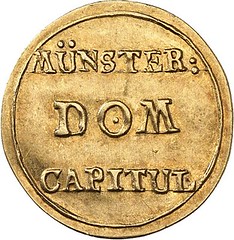

Lot 1824: MÜNSTER. Gold pattern struck by dies of the copper pfennig 1790.Weinrich 75 note. Extremely rare. Extremely fine. Estimate: 2,500,- euros. Hammer price: 12,000,- euros
Lot 2560: PRUSSIA. Frederick William I (1713-1740). Williams dor 1740 EGN, Berlin. Fb. 2363. Rare. Very fine to extremely fine. Estimate: 3,500,- euros. Hammer price: 24,000,- euros
Lot 2599: PRUSSIA. Frederick William I (1713-1740). Reichsthaler 1714, Neuenburg. Dav. 1777. Very rare. About extremely fine. Estimate: 15,000,- euros. Hammer price: 40,000,- euros
Lot 2738: PRUSSIA. Frederick II (1740-1786). Prussian reichsthaler 1752 C, Cleve. Dav. 2584. Extremely rare in this grade. About proof-like. Estimate: 4,000,- euros. Hammer price: 34,000,- euros
Lot 2753: PRUSSIA. Frederick II (1740-1786). Speciesthaler 1755, Berlin. Dav. 2592. One of 16 specimens struck by the original dies posthumously in 1787. First strike. About proof-like. Estimate: 30,000,- euros. Hammer price: 65,000,- euros
Lot 2757: PRUSSIA. Frederick II. (1740-1786). Levantethaler 1767, Berlin or Magdeburg. Dav. 2596. Old. 372. Extremely rare. Extremely fine. Estimate: 10,000,- euros. Hammer price: 30,000,- euros
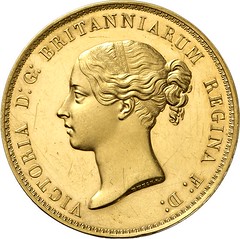
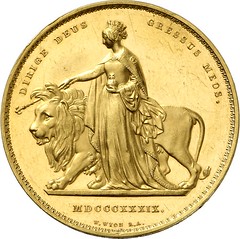
Lot 3078: GREAT BRITAIN. Victoria (1837-1901). 5 pounds 1839, London. “Una and the Lion”. Seaby 3851. Very rare. Proof. Estimate: 50,000,- euros. Hammer price: 65,000,- euros
Lot 3145: POLAND. Sigismund III (1587-1632). 5 ducats 1623, Bromberg. Fb. 78. Only three specimens known to exist. Extremely fine to proof-like. Estimate: 125,000,- euros. Hammer price: 170,000,- euros
Lot 3202: CZECHOSLOVAKIA. Republic. 10 ducats 1951, Kremnitz. Fb. 4. Mintage only 56 specimens. About proof-like. Estimate: 15,000,- euros. Hammer price: 50,000,- euros
Lot 3295: MAROCCO. Hassan II (1962-1999). 5 Dirhams 1965 / 1384 AH. pattern. Very rare. About proof-like. Estimate: 1,000,- euros. Hammer price: 11,000,- euros
Lot 3489: BRUNSWICK-WOLFENBÜTTEL. Charles I (1735-1780). 10 thaler 1779, Brunswick. Fb. – (see 713). Probably unique specimen. About proof-like. Estimate: 10,000,- euros. Hammer price: 20,000,- euros
Lot 3521: HESSE-KASSEL. William (IX) I (1785-1803-1821). 5 thaler 1820, Kassel. Fb. 1292. Probably the only specimen available on the market. Extremely fine. Estimate: 30,000,- euros. Hammer price: 34,000,- euros
Lot 3561: NUREMBERG. 6 ducats 1698 on the anniversary of the Treaty of Ryswick. Fb. 1872. Very rare. Extremely fine to proof-like. Estimate: 7,500,- euros. Hammer price: 44,000,- euros
Lot 3783: RUSSIA. Ivan III (1740-1741). Rouble 1741, St. Petersburg. Dav. 1676. Extremely rare. Very fine. Estimate: 30,000,- euros. Hammer price: 52,500,- euros
Lot 3953: RUSSIA. Alexander I (1801-1825). Rouble 180_, St. Petersburg. Pattern Bitkin 666. Very rare. Extremely fine to proof-like. Estimate: 30,000,- euros. Hammer price: 48,000,- euros
Lot 4064: RUSSIA. Nicholas I (1825-1855). 1 1/2 rouble (10 zlotych) 1836 (minted in 1836/7), St. Petersburg. Family rouble. Dav. 286B. Mintage only 15 specimens. About proof-like. Estimate: 50,000,- euros. Hammer price: 85,000,- euros
Lot 4151: RUSSIA. Alexander II (1855-1881). Gold medal 1859 by P. Brusnitsyn on the erection of the monument for Nicholas I in St. Petersburg. Diakov 681.1. Very rare. Extremely fine to proof-like. Estimate: 75,000,- euros. Hammer price: 100,000,- euros
Lot 4283: RUSSIA. Nicholas II (1894-1917). Silber badge 1914 by K. Fabergé on the initial plans for the construction of a submarine boat by Noblessner. In original green casket. Extremely fine. Estimate: 1,000,- euros. Hammer price: 22,000,- euros
Lot 4520: IMPERIAL COINAGE. 1/2 mark 1908 AB. J. 16. Extremely rare. Proof. Estimate: 6,000,- euros. Hammer price: 10,000,- euros
Lot 4705: IMPERIAL COINAGE. Saxony. Frederick August III (1904-1918). 3 mark 1917 E. On the 400th Jubilee of the Reformation. J. 141. Very rare. Proof. Estimate: 60,000,- euros. Hammer price: 67,000,- euros
Lot 5063: IMPERIAL COINAGE. Saxe-Coburg-Gotha. Ernst II, 1844-1893. 20 mark 1872. J. 270. Rarest type of all imperial gold coins. Good very fine. Estimate: 40,000,- euros. Hammer price: 52,500,- euros
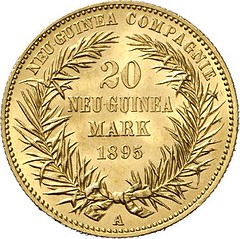
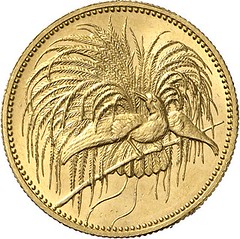
Lot 5128: GERMAN NEW GUINEA. 20 New Guinea mark 1895 A. J. 709. Very rare. About proof-like. Estimate: 20,000,- euros. Hammer price: 30,000,- euros
Lot 5509: IMPERIAL COINAGE. Saxony. Frederick August III (1904-1918). 3 mark 1917 E in aluminium. Schaaf -. Beckenbauer Coll. -. See J. 141. Unique specimen. Extremely fine. Estimate: 5,000,- euros. Hammer price: 15,000,- euros
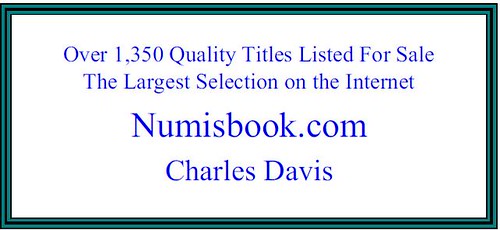
JACQUIER AUCTION SALE 39
12 September, 2014
Paul-Francis Jacquier, Kehl am Rhein
Auction sale 39 – Classical Coins and Ancient Art
Superb rarities in Jacquier auction sale 39
A selection of superb gems can be found in the catalog of the upcoming auction sale #39 of Paul-Francis Jacquier. The focus is on the Greek east, rare antoniniani and the Gallic Empire. Additionally, the connoisseur discovers two pfennige of Charlemagne from Mainz that are of the utmost rarity.
You better mark the following date in your calendar: 12 September 2014, 4 p.m. sharp. This is when the 39th auction sale of Paul-Francis Jacquier starts. Once again he has managed to assemble an extremely attractive offer of rarities for the advanced collector. Almost 1,100 lots of ancient coins, cut gemstones, mobiliary art objects and numismatic literature will be auctioned off.
Within the 22 Celtic and 141 Greek coins the aficionado detects numerous pieces that stand out, be it due to their rarity, their historical importance, their appeal, their provenance, or a combination of all of these criteria. The selection of rare fractions and bronzes is particularly broad.
The main focus of the material, however, is on another special field that has been cultivated in the house of Jacquier for many years: The Greek east which is represented by 137 lots.
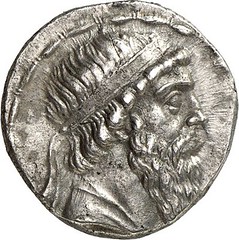
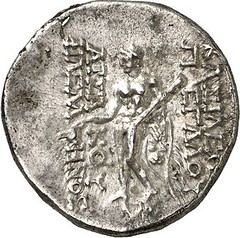
((166 – Mithradates I, 164-132 (Parthians). Tetradrachm, Seleucia on the Tigris, c. 141/40. Sellw. 13. 2. Shore 35. Sunrise 260. Ex Peus 363 (2000), 5104. Very rare. Extremely fine. Estimate: 3,500 euros))
Even he who has dealt with this field for a long time will learn something new in the notes since latest research had its influence on the catalog. Hence, the non-expert soon gets confused by all these names, of peoples, countries and rulers, ones he had never come across so far: Artav and Safshafan of Choresmia, the Paratarajas or Alchan. If you have no clue as to what these terms mean than you should take a look at the catalog. The Empire of the Arsacids – or, as it is also referred to – the Parthian Empire kicks the section off. And the connoisseur discovers rarities like the very rare tetradrachms of Mithradates I (estimate: 3,500 euros) and of Artabanos II (estimate: 4,000 Euro).
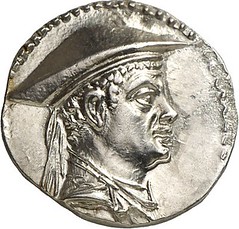
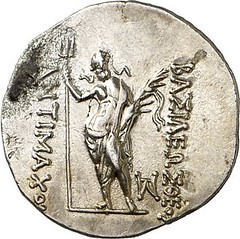
((202 – Antimachos I, 174-165 (Bactria). Attic drachm. Mitchiner 125. Bopearachchi, series 2C. SNG ANS 282. Very rare denomination. Apart from material defect in the reverse good extremely fine. Estimate: 800 euros))
Charakene, Elymais and Persis lead over to Bactria with its gorgeous tetradrachms depicting the monumental portrait heads of its rulers. Agathocles in the name of Euthydemos (VF+, estimate: 3,000 euros), Antimachos I (splendid specimen, estimate: 3,000 euros) or Eucratides I (splendid specimen, estimate: 2,000 euros) are all represented by tetradrachms. Anyone diving deeper into this subject will notice the excellently preserved drachm of Antimachos I which as denomination is significantly rarer than any tetradrachm of this field.
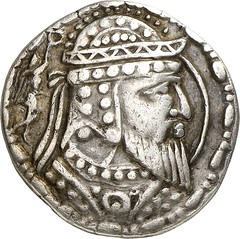
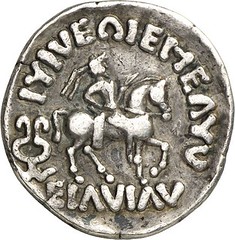
((211 – Artav (Choresmia). Tetradrachm, 1st cent. A. D. Sunrise 517. MIG Type 498. Ex Triton XII (2009), 415. Extremely rare. Good very fine. Estimate: 7,500 euros))
Margiana, Sogdiana, Choresmia – the names of the provinces are getting more exotic by the minute. And it is only very few people that have ever heard of Artav who ruled the last of the aforementioned provinces in the 1st cent. A. D. An extremely rare tetradrachm of this ruler is on offer that ranges stylistically between the Parthian and the Bactrian coinage.
The Indo-Scythians, the Kushan Empire, Guptas and of course the Sasanids with many a rarity, covering Ardashir I, Vahram I and Buran – they are all there to find. The section is concluded by a vast selection of Kidarites and coins of the Alchan.
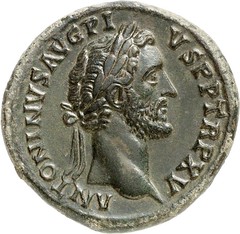
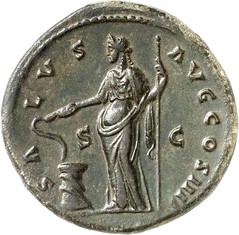
((365 – Antoninus Pius, 138-161. Sestertius, 152. RIC 886. BMCRE 1901. Extremely fine. Estimate: 3,000 euros))
Roman coins are next in line, beginning with the coinage of the Civil Wars, including some portraits of Cesar, and of Marc Antony and Octavian as well. Anyone fond of fine bronzes will be thrilled by the range of offer from Roman Imperial Times. Tesserae from the 1st cent., marvelous sestertii and bronzes of the Greek cities under Roman rule – every single piece was selected with due regard to a fine patina.
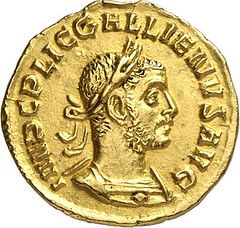
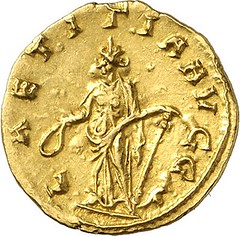
((492 – Gallienus, 253-268. Aureus, 253-254. RIC 79. MIR 46p. Ex Huntington Collection (HSA 30107). Rare. Extremely fine / about extremely fine. Estimate: 10,000 euros))
Customers of Jacquier are well aware of the fact that especially the offer of coins from the second half of the 3rd cent. A. D. beats everything that can be encountered in other auction sales. The aureus of Gallienus from the Huntington Collection, therefore, may be the most expensive item of the section – but to the collector the small series of animal depictions dating to 267/8 is every bit as interesting.
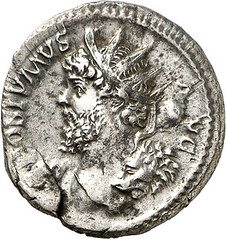
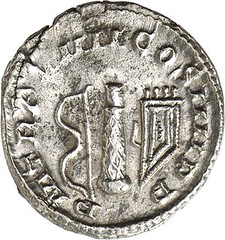
((527 – Postumus, 260-269. Antoninianus, Cologne, 1st half 268. AGK 65b. Elmer 560. Cunetio 2445. Very rare. Extremely fine. Estimate: 3,500 euros))
And of course the rarities from the Gallic Empire represent a bigger part of this auction sale as well. Just think of the rare antoninianus from Cologne that features Postumus with the attributes of Hercules. You will also find a second example of the coin type bearing the first time the name of Cologne like the one that had been sold in auction #38 for 2,400 euros.

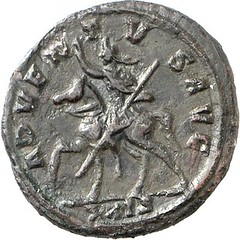
((624 – Probus, 276-282. Antoninianus, Siscia, 277. RIC 627. Ex Roma III (2012), 535. Extremely rare. Extremely fine. Estimate: 2,000 euros))
Outright spectacular is the material assembled under the heading “Special Collection of Rare Antoniniani (268-294)”. The collector had made quite sure about sorting the wheat from the chaff. He who loves special busts is requested to examine the offer with particular care. The emperor with shield and spear, holding the horse by the reins, or in consular garment with trabea and eagle scepter, not to forget heroic nudity: the 122 pieces of this collection provide a good sample of the rarities that are hidden amongst the mass coinage of this era.
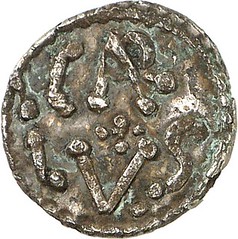
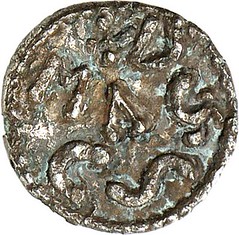
((851 – Charlemagne, 768-814. Denarius, Mainz, c. 768-775. Gariel VIII, 82. Morrisson / Grunthal 262. Prou 937. From Belgian private collection (1960s). Of utmost rarity. Very fine. Estimate: 7,500 euros))
A small sensation from the early Middle Ages is on offer as well, appropriate to the occasion of the 1200th anniversary of the death of Charlemagne: Two denarii from the Mainz mint, the first one struck between 768 and 775, the second one between 793/4 and 814.
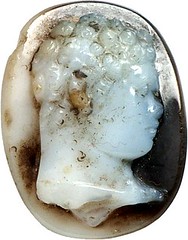
((885 – Cameo. Layered agate, 1.8 x 1.4 x 0.6cm. Bust of juvenile Hercules or Caracalla, lion skin (?) around neck. Late 2nd / early 3rd cent. A. D. Estimate: 1,450 euros)) A fine selection of a number of gems, objects of ancient mobiliary art objects like fibulae and clay lamps as well as numismatic literature conclude the offer.
The fully illustrated catalog can be ordered against a protective fee of 12.50 € at Paul-Francis Jacquier, Honsellstraße 8, D-77694 Kehl am Rhein, phone: 07851 / 1217, email: office@coinsjacquier.com
To do Live Bidding, please register in time at www.coinsjacquier.com.
You can view the auction catalog on the internet at www.sixbid.com/browse.html?auction=887
BALDWIN'S HONG KONG COIN AUCTION 57
A.H. Baldwin & Sons Ltd and auction partner Ma Tak Wo Numismatic Co Ltd are pleased to announce that the Hong Kong Coin Auction 57 will be one of the largest sales to date. Held as part of the bi-annual Hong Kong International Coin Convention and Antique Watch Fair, the sale will feature a Kuang Hsu, Gold Ku’ping pattern Tael, alongside Chinese coins from the collection of Åke Lindén, French Indo-Chinese and Trade Dollars from the Johanna Austin collection, and a private collection of Plantation Tokens. The sale will be held on Thursday 21 August 2014 in Hong Kong’s Kowloon.
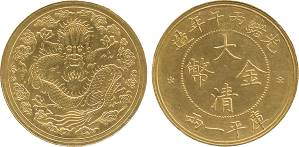 A splendid example of the Gold Ku’ping Pattern Tael, struck under the eleventh emperor of the Qing Dynasty, Kuang Hsu, leads the Chinese Coins in the sale. This rare coin, created as a prototype coin in Kuang Hsu’s 33rd year, never saw full circulation and is one of the few Chinese imperial gold coins struck at an official mint. It is estimated at US$65,000-85,000. [Lot 286]
A splendid example of the Gold Ku’ping Pattern Tael, struck under the eleventh emperor of the Qing Dynasty, Kuang Hsu, leads the Chinese Coins in the sale. This rare coin, created as a prototype coin in Kuang Hsu’s 33rd year, never saw full circulation and is one of the few Chinese imperial gold coins struck at an official mint. It is estimated at US$65,000-85,000. [Lot 286]
Representing the highly regarded collection of Åke Lindén in the sale, is an exceptional collection of Chinese Coins including a Kirin Province, silver 50-Cents with Manchu characters estimated at US$10,000-12,000 and a very rare Peking Mint, silver pattern 10-cents estimated at US$10,000-12,000. [Lot 283]
From the Johanna Austin collection is a French Indo-China proof set from 1889A. Only 100 sets, comprising Bronze Sapèque, Cent, Silver 10-Cents, 20-Cents, 50-Cents and Piastre, were ever issued, this example is complete with gilt decorated blue leather case of issue and is estimated at US$20,000-25,000. [Lot 693]
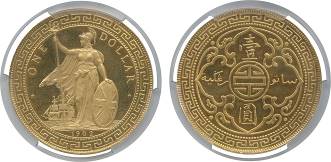 Exacting buyer Johanna Austin had a particular interest in the coinage of South East Asia, specifically French Indo-China, Vietnam and Hong Kong. The collection also displays her interest in the trade coins used in the region, with the various nations who produced them all represented here. Of special note is an extremely rare example of a British Trade Dollar, 1902B, struck in gold, which is estimated at US$30,000-35,000 [Lot 1052]. The proceeds of the sale of Johanna Austin’s collection will go to the Museum of East Asian Art in Bath, England.
Exacting buyer Johanna Austin had a particular interest in the coinage of South East Asia, specifically French Indo-China, Vietnam and Hong Kong. The collection also displays her interest in the trade coins used in the region, with the various nations who produced them all represented here. Of special note is an extremely rare example of a British Trade Dollar, 1902B, struck in gold, which is estimated at US$30,000-35,000 [Lot 1052]. The proceeds of the sale of Johanna Austin’s collection will go to the Museum of East Asian Art in Bath, England.
Leading an extensive opening section of banknotes will be a 14th century Ming Dynasty 1-Kuan banknote. Probably the oldest paper money in the world, the 1-Kuan note was printed on mulberry bark which was believed to have been recycled from the waste of government ministries and Civil Service papers. Text at the lower section of the note reads; “This noted of the Great Ming is printed with the approval of the Hung Wu Emperor (Year 1368-1398) through the Hu Pao and used side by side with copper cash, Those who counterfeit the Great Ming notes will be beheaded while an informant will be rewarded with 250 Taels of silver and with confiscated property of the convicts into the bargain”. From the renowned Danish, Sophus Black Collection, this note is rarely found in such high grade and is estimated at US$12,000-15,000. [Lot 1]
The auction will be held on Thursday 21 August 2014 in the Crystal Room, Level B3, Holiday Inn Golden Mile, 50 Nathan Road, Kowloon, Hong Kong. The catalogue is available to view online at www.baldwin.co.uk. For more information and viewing times please contact auctions@baldwin.co.uk.
WAYNE'S NUMISMATIC DIARY: JULY 27, 2014
Yesterday, July 26, 2014, I got in my car and headed toward the Annandale, VA coin show where I'd be helping to run an event for young numismatists. I arrived about 10am, just after the show had opened to the public. I spoke briefly to Karin and Wayne Herndon (organizer of the show), then made my way upstairs to the meeting room.
Tom Kays was already there and had set out all of the lots for the auction. I helped set up the registration and giveaway tables out in the hallway. The freebies included a number of U.S. Mint bookmarks and other promotional materials, and perhaps a hundred Whitman blue coin folders. I separated them by denomination and type, which spanned everything form Indian Head Heads to Kennedy Half dollars.
Kids and their parents began arriving just before 11am. Many had been to these events before, and knew the drill. Everyone got 10 auction dollars in an envelope.
I welcomed everyone and described the program. I tried to engage them with some questions, but I was dying - the crowd was pretty silent. Usually I can get them going, but I was clearly having an off day. I punted over to our guest speaker and hoped for the best.
Wayne Herndon had arranged for Paul Joseph from ANACS to speak on grading. I shouldn't have worried. A retired educator, Paul was interesting, engaging and funny. Despite a shipping snafu that left him without many sample coins to pass around, he led a great impromptu discussion. Without examples focusing on the HOW of grading, he way able to focus more on the WHY of grading - why it's important and what it means to the individual collector.
The audience had many great questions for him. He was only stumped by one - "Why are coins round?" What a GREAT question! I'd fielded the same question before from a group of kids and had had some time to think about it. So I butted in and asked them to think about smashing a blob of Play-Doh with a mallet. What shape would the Play-Doh look like? A triangle? A square? Well, it would actually be fairly round, as the squished material flattens out in all directions.
This led to later discussions of metal flow and the cartwheel effect. Although it was spontaneous, the banter worked pretty well, and served as a great introduction to some pretty advanced topics. But these kids are smart, and I'd like to think some of it sunk in.
Next was the auction. Tom Kays described the lots, Eric Schena called the sale, and Heather Schena was the runner, delivering lots and collecting auction dollars. The bidding was active on most of the lots, which included a coin from the 1750s, a Peace Dollar, some $1 Star notes, a mystery bag of coins and tokens, and a starter set of about 20 sales tax tokens. Many thanks to Tom for donating several of the lots.
Everyone had a great time. Most of the giveaway Whitman folders had disappeared. Afterwards Tom, Eric, Heather and I talked about the program. The kids are so smart and engaged it’s a pleasure to work with them. Wayne's already working on our next speaker, and has a volunteer to talk about ancient coins. We're looking forward to it!

THE COIN-CARVING ART OF SHAUN HUGHES
Spider-Man
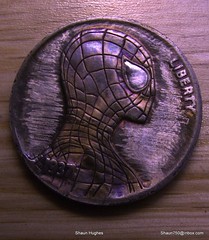
Marilyn Monroe
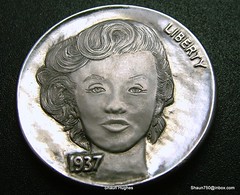
Chucky
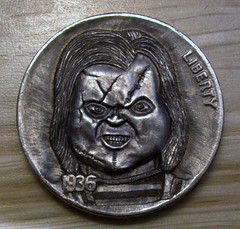
Roosevelt Skull
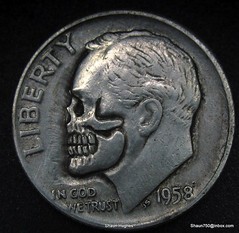
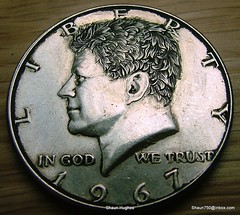
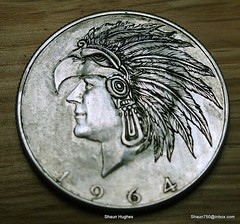
To read the complete article, see: Artist Hand Carves The Presidents On Coins Into Famous Pop Culture Characters (news.distractify.com/culture/shaun-hughes-hobo-nickels/)
ON THE LEGALITY OF CUT-OUT COINS
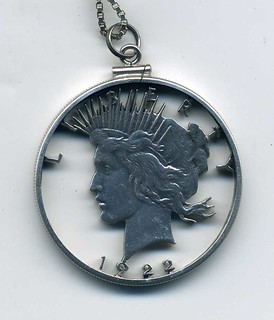
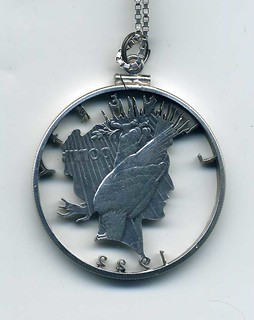
Heather Schena writes:
People often comment about the legality of my cut out 1922 Peace Dollar (which I wear most of the time); some suggest that it is just wrong or unpatriotic to cut a US coin. Apparently those who make this jewelry get those comments as well, since I found a note on an eBay sellers' profile addressing this issue:
We have all see Cut Coin Jewelry as pendants, or necklaces, in money clips, on earrings, and in belt buckles. Many people see the familiar coin, notice it is a "cut out coin," and then say,
"It's against the law to do that to a coin!"
"Isn’t that illegal to cut out a U.S. Silver Dollar Coin?"
""You can get in trouble for defacing money!"
I hear questions and comments like these every so often after someone sees cut out coins for jewelry. Maybe you too had assumed Cut Coin Jewelry is considered the defacing of the coin, and thus illegal to do so.
Rest assured the cut coins you see here on eBay and eBay express, such as cut-coin money clips or state quarter charm pendants do not violate any U.S. statute provided that the alteration to the coin is not done with fraudulent intent.
These handsome and beautiful coins are done for a purpose -- jewelry, not with intent to defraud.
To read the complete article, see: Is it illegal to cut out coins? (www.ebay.com/gds/CUT-COIN-Jewelry-Is-Coin-Cutting-Legal-OK-or-Illegal-/10000000001433735/g.html)
THE EDWARD MEDAL
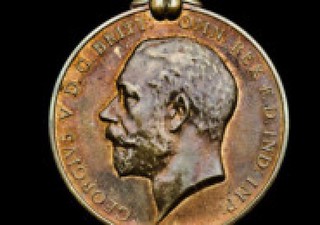 A rare medal awarded to a gallant South Kirkby miner for rescuing a buried colleague is to be auctioned off today.
A rare medal awarded to a gallant South Kirkby miner for rescuing a buried colleague is to be auctioned off today.
The Edward Medal - a forerunner of the George Cross - was presented to George Smith in 1922 after he risked his life to save a fellow miner who was trapped for eight hours after a roof fall at the pit.
The medal is expect to fetch around £1,000 when it is goes under the auctioneer’s hammer in London later today.
Mr Smith’s bronze medal is expected to fetch between £800 and £1,200 when it is auctioned at Spink in Bloomsbury, London.
The medal was named after King Edward VII and was introduced in 1907 to recognise “acts of bravery by miners, quarrymen and industrial workers in mines and factory accidents and disasters.”
The medal was replaced in 1971 by the George Cross.
The Edward Medal (Mines) was awarded only 395 times, making it one of the rarest of British gallantry awards.
To read the complete article, see: Medal goes under hammer (www.hemsworthandsouthelmsallexpress.co.uk/news/local-news/medal-goes-under-hammer-1-6744817)
To read the complete Spink lot description, see: Edward Medal (Mines), G.V.R., 1st type, bronze (George Smith. (/www.spink.com/lot-description.aspx?id=14002000015)
ZIMBABWE'S DOLLARS
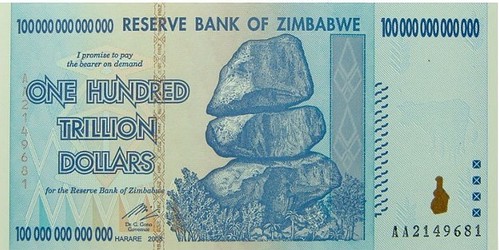
Anyone who has been to Victoria Falls, Zimbabwe has had the surreal experience of seeing a real $100 trillion dollar bill. The world’s largest waterfall now competes with the world’s largest banknote, and the latter have steadily replaced carved wooden elephants as the quintessential souvenir pushed by hawkers around town.
When I visited in October 2011, Zim dollars had been out of circulation for nearly 3 years, a casualty of the country’s losing bout with hyperinflation, which escalated as Zimbabweans (and currency traders) became less and less certain of the country’s future, and therefore of the value of its currency. When inflation reaches a certain level, the lack of confidence in the local currency becomes pervasive, and the yo-yo’ing gets worse and worse every time new bills are released. By the summer of 2008, months before the Zim dollar was taken out of circulation, inflation reached 231 million percent, and the government stopped keeping track. By November estimates reached a number I can’t even pronounce: 89,700,000,000,000,000,000,000%.
By 2009, Zimbabwe’s economy was almost completely “dollarized,” with most retailers accepting only foreign currency. Now, the country runs on American dollars as worn and beaten up as any money you’ve ever seen, because the US Mint isn’t there to supply Zimbabwe with fresh bills. American change — quarters, dimes, nickels — is so rare that shopkeepers are likely to refuse it.
But in a country where most people live on less than a dollar a day, having a dollar as your smallest denomination has obvious problems. For transactions involving uneven dollar amounts, stores unflinchingly provide you change in two currencies: American dollars and South African Rand, worth about 10 cents. If a cashier is short on Rand, he’ll hand you a slip of paper promising, say, 63 cents in store credit, or — no joke — the equivalent value in lollipops, bubblegum, or mints. Officially, Zimbabwe now has four legal currencies, the third and fourth being the Euro and the Pound, but in practice, neither is nearly as common as hard candy.
Namotolo, a softspoken man with hollow cheeks and a startlingly deep voice, is one of a few dozen people in Victoria Falls who makes his living selling Zim dollars as souvenirs. For $10 US, you can buy a whole set — ranging from $100 trillion down to 100,000, which seems almost banal by comparison. “We almost came to the octillion,” Namotolo told me in his singsong Shona accent, stretching octillion to four clear syllables. “Twenty seven zeroes. Do you know that one? The green one?
“Nobody knows,” he went on, “but we know because we are surviving on selling these notes.” The currency was abandoned before octillions made it out of the bank, but you could still find one on the souvenir market, he said, if you looked hard enough.
Along several blocks of restaurants, gift shops, and safari outfitters, men like Namotolo stand curbside tempting tourists with wads of billion dollar bills. “The time we started,” Namotolo said, “we were selling some wooden carvings and some stone carvings on the street, you see? Some tourists started asking for Zim dollars — they started buying Zim dollars when it was still working, while they were in circulation.”
Suddenly, Zim dollars, viewed as artifact rather than currency, became a source of foreign exchange. The shift not was without irony: at the time, the utter lack of foreign currency available to Zimbabwean banks was a key factor driving the government’s incessant printing of new money. If not for buying them as souvenirs, tourists had essentially no contact with local currency, and you could tell from Namotolo’s voice what a revelation this had been. “These things!” he said. “You could use them, sell them as souvenirs.”
Three years later, the trade for Zim dollars turned on tourists’ reliable fascination with Zimbabwe’s economic demise, and on the reluctant disillusionment of thousands of civil servants and farmers living in the countryside. These are Namotolo’s suppliers, people who saw their life savings evaporate during the inflation crisis.
As inflation skyrocketed in 2007 and 2008, teachers’ pensions became worthless overnight, and, stacks of large bills hidden under mattresses shrank to the equivalent of so many pennies, or even less.
To read the complete article, see: My brother went to Zimbabwe, and all he got me was 100 trillion dollars (medium.com/african-makers/my-brother-went-to-zimbabwe-and-all-he-got-me-was-100-trillion-dollars-1b94cf1916b7)
FEATURED WEB PAGE: GASPARRO AND ROBERTS ON KENNEDY HALF
This week's Featured Web Page is from the U.S. Mint web site.Reference copy of a letter to Director Adams from Acting Philadelphia Mint Superintendent regarding the recollections of United States Mint Engravers, Frank Gasparro and Gilroy Roberts, production of the Kennedy Half-Dollar.
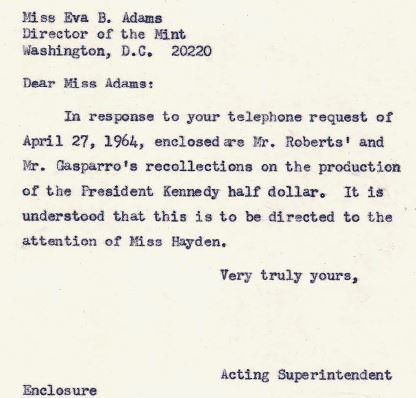
www.usmint.gov/historianscorner/?
action=DocDetail&ID=29290&
CFID=48502432&CFTOKEN=70434197
